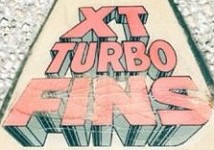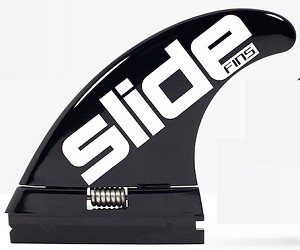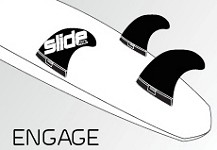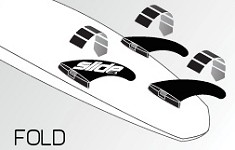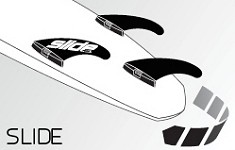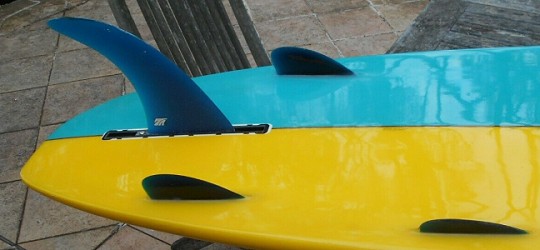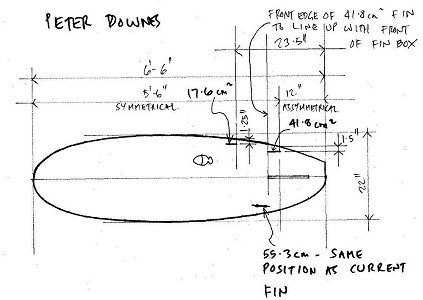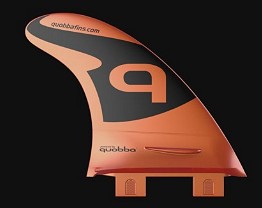surfresearch.com.au
 |
surfresearch.com.au
the
catalogue : surfboard fins
|
the catalogue : surfboard fins
The fin, or skeg,
is a hydrodynamic
blade attached on the bottom of the board at the tail.
For hundreds of years, Polynesian surfers rode their surfboards
without fins, and in the early twentieth century, the fin-less
Hawaiian surfboard was exported around the world.
Shallow, long based skegs, were introduced by Tom Blake in 1935,
but it was only after the development of the lightweight
fibre-glassed balsa board that the fin became integral as a
defining feature of the modern surfboard.
By providing drag, in fact
slowing the board's speed, the fin gives direction and stability,
vastly improving the rider's control.
Fin
Performance
1. Any discussion of surfboard fin performance must first be
based on an understanding of surfboard dynamics.
Critically, surfboards are planning hulls, as
noted by Lindsay
Lord (1946), planning on the meniscus, the
barrier between the surface of the wave and the air.
Conversely, the fin is hyrodynamic, that is, it travels through
the water, and thus performs
according to displacement hull principles.
2. The assessment
of surfboard performance is essentially subjective, the rider
invariably refering to the feel of the board or fin, and
the vast majority of surfers' knowledge about boards and fins is
"incorrect, inaccurate, and unclear."
For example see the current wikipedia entry.
3. With a change in the design, dimensions, or position of the
fin on a surfboard, the rider invariably reports a change the feel
of the board.
4. The difficulties associated with a
"technical" analysis of fin performance and considerable,
and a "large influence on the design relates to
aesthetic considerations and perceived market
expectations."
- Anthony
Livanos (Faculty of Engineering University of Western
Australia):
Computational
Fluid
Dynamics Investigation of Two Surfboard Fin
Configurations.
.members.iinet.net.au/~livanos/CFD_report/Report.doc
History
While
the first use of the surfboard fin is commonly accredited to Tom
Blake (Hawaii) in 1934, the contributions to fin design by Blake and Bob
Simmons (1946-1949) are substantially over-rated.
The first use of a fin, skeg or keel on a surfboard was probably
over one hundred years earlier by the inhabitants of Pitcairn
Island; combining traditional Polynesian design, imported from
Tahiti, and European boat-building.
In 1821, Dr. David Ramsey described
their surfboards as a flat board about 3 feet long, on the
upper side smooth and on the under a ridge like a keel.
See Surfriding
on Pitcairn Island.
Extracts from
The Scrapbook of the Log of the Ship "Surry",
Pitcairn Island, April 1821, page 7.
The most significant work was by George Downing, Woody Brown and
Wally Froiseth in
Hawaii, and Joe Quigg in California in the late 1940s.
They were followed by George
Greenough (1965-1970) and Simon Anderson (1980-1983).
Dimensions
The standard dimensions are height (or length or depth), base,
span, and distance set from the tail.
Other rarely
considered specifications are surface area (often noted on
sailboard fins), thickness and the foil or cord.
See below.
Fin
Nonsense, 2014:
Surfersvillage
Global Surf News
29 May, 2014 - DESIGN: In some
of the most challenging conditions ever seen for a womens
ASP Tour event, Aussie golden gal Sally Fitzgibbons has
emerged victorious over Steph Gilmore while riding the new
FCS II system and the JW Medium fin template.
Over the course of the event competitors were forced
to adjust from the long open face walls of Cloudbreak to the
funnelling barrels at Restaurants.
Mixing backhand tube riding with powerful carves ...
Steve Wilkings
Photography
http://www.stevewilkings.com/default.php
Select: 1932
and Search. |
1932
Bill Wheeler Keel Fin
A
prone board
fitted with a
white long
based keel
fin, mounted
with four
metal
L-brackets.
An ACME
News service
photo of
Margaret Olson
holding a new
type of
surfboard
designed by
Bill Wheeler.
Photo was
taken May 10,
1932.
|
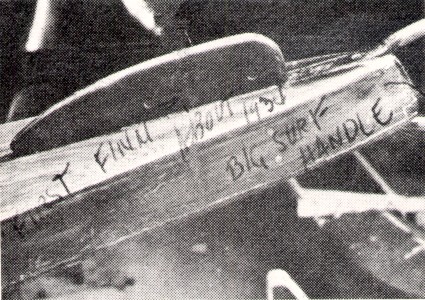 |
circa 1934
Tom Blake's Nub - Keel
Fin
solid timber
2 x 12 b @ 4 inches (Approximation)
Tom Blake's first fin with Big
Surf Handle
Photograph and hand written
caption
by Tom Blake.
Surfer Magazine,
March 1981, Volume 22, Number
3,
page 37.
|
Of
all the hundreds of pre-1935 photos I've studied at the
Bishop, the Hawaiian State Archives, and on the mainland, I
have never seen a legitimate photo of a board with a fin
prior to Blake's1935 fin - it just didn't happen before 1935,
regardless of what others say.
- Gary Lynch :
Australian Surfers Journal Vol 3 No 1 Summer 2000 page 10.
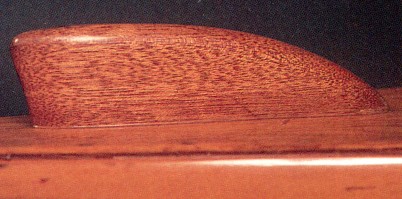
|
circa 1935
Nub Fin/ Keel
Tom Blake
solid timber
2 x 12 b @ 6? inches (Approximation)
Photograph: Bjorn
DeBoer :
LONGBOARD Magazine
Vol 4 No 5. 1996
November/December
page 68
|
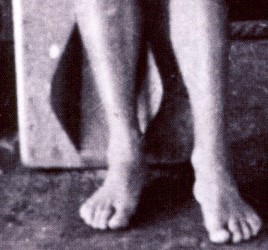
|
circa 1943,
Tom Blake Twin fins,
Timber
4 x 12 b @ 2 inches (Approximation)
Hollow timber board.
Note fin camber.
The feet are Tom Blake's.
Uncredited photograph,
Australian Surfers Journal
Vol 3 No 1 Summer 2000 page
10.
|

|
1942
Keel Fin - Pacific Systems
Homes
Redwood - varnished
2 x 14 b @ 3 inches
(approximation)
Waikiki Surf Board Model
Pacific Systems Homes Inc, L.A.
California
Spencer and Annette Croul
Collection
Blackburn,
page 60
|
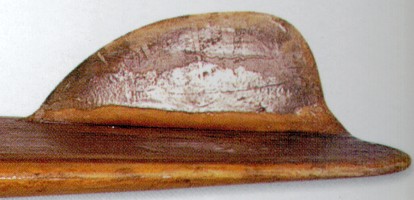
|
1946 - 1947
Simmons'
Radius Fin - Rounded Keel
Wood and
fibreglass
6 x 12 b @ 2 inches
(approximation)
Bob Simmons' Laminate Board,
USA.
Hoffman collection
Blackburn,
page 72
|
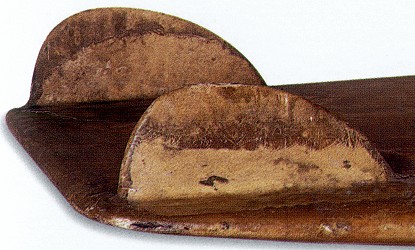 |
1948
Simmons'
Twin Fin
Wood and
fibreglass
6 x 12 b @ 2 inches
(approximation)
Bob Simmons' Laminate Board,
USA.
Dick Metz Collection, Dana
Point, California.
Blackburn,
page 73
|
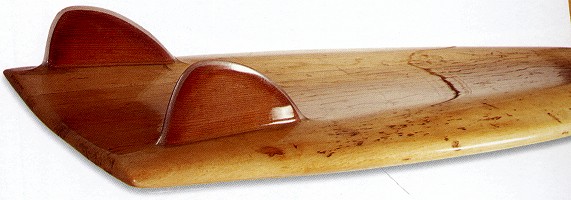
|
1949
Simmons'
Twin Fin
Wood and
fibreglass
7 x 10 b @ 3 inches
(approximation)
Bob Simmons' Balsa Board, USA.
Note concave tail
section.
Hoffman Collection.
Blackburn,
page 77 |

|
1949
Simmons' Radius Fin -
Rounded Keel
Koa Wood and fibreglass
3 1/2 x 13 1/2 b
inches
Surfer Magazine
The Malibu Fin Appendix
Volume 17 No 2 July 1976 ,
page 69
|
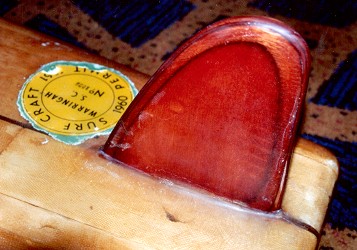
|
circa
1949
'Hot Curl' Laminated
Fin
Laminated timber and
fibreglass
7 x 6 1/2 b @ 1 1/2 inches. Pod
8 1/2''
Warringah Surf Permit 1960-1961
: #1099
23. HOT CURL SURFBOARD
/ SOLID TIMBER - approx. 10', late 1940's, replica
fin taken from the original (recently broken)...
Notes, dimensions and
photograph :
Sydney Surf Auction,
Mona Vale Hotel,
Sydney, 30 October 2005
Catalogue No. 23
Thanks to Mick Mock
|
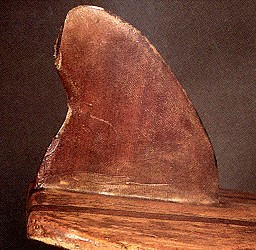
|
circa 1950
Timber Addition
8 x 10 b @ 0 inches (Approximation)
Fixed to board, if not
laminated, by fibreglass.
Possibly added post production
to a solid timber board.
Note broken tip.
USA
Photograph :Bjorn DeBoer
LONGBOARD Magazine
Vol 4 No 5. 1996
November/December
page 68
|
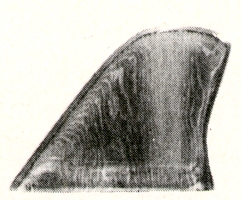
|
1953
Simmons' Removable
(Wedge fit into channel)
Marine Plyood
4 1/2 x 6 (b)
inches
Surfer Magazine
The Malibu Fin Appendix
Volume 17 No 2 July 1976 ,
page 69
|
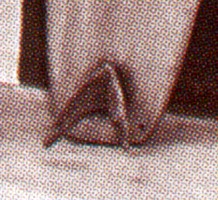
|
1955
Butterfly Fin
Laminated Timber
8 x 7 b @ 4 inches (Approximation)
Velsy-Jacobs Surfboards USA
Futuristic in template and
concept
Revived 1978
Photograph : Bob Meistrell
Longboard Magazine
Vol 12 No 1 March -April
2004 page 33.
|
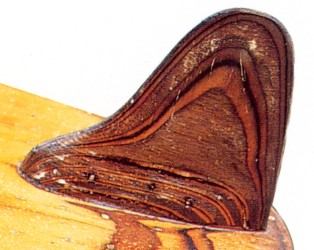
|
circa 1957
Wood fin,
8 x 9 b @ 1 inches (Approximation)
Okinuee - Hollow malibu board
adaptation.
Note base support and nails.
Brisbane Australia,
Darryl Homan collection
Photograph : Michael Simmons
Australian Surfers
Journal
Vol 3 No 1 Summer 2000 page
38
|
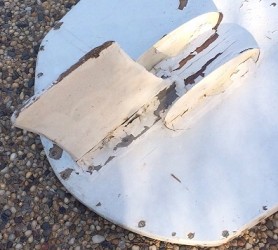
|
circa
1959
Hatchet fin and two Moon
keels,
|
|
circa
1958-1965?
Dorsal Aluminium Screw-on Fin
Cast aluminium
with six screw-holes, three each side.
Fin blade: 7'' x 7'' base
Fin and base: 8" x 8.5" base
Base: 1" height x 8.5" length x 1.5" width
Found by Mark Jackson in 2018
at a Wollongong garage sale in a
box with two used fibreglass fins from lifesaving paddle
boards.
Consistent with the collection,
this fin was possibly made to be screwed onto timber
surfboard, or even a timber surf-ski, possibly used by a
surf lifesaver.
The fin was perhaps cast in the
late 1950s following the introduction of the Malibu board
to Australia in late 1956.
However, the template and the foiling of the fin is
advanced for the suggested 1958, these not becoming
standard features until the mid-1960s.
Thus it might have been intended to screw onto a foam
board with a very wide stringer (at least 1.5") or into a
suitably located block of wood
inserted in the blank before
glassing.
The construction, although much larger, is similar to
bolt-on fins, or skegs, used on water skis of the period.
The remnant screw head in one hole suggests the fin was
affixed and used on a board at some time.
Dimensions and images contributed by Mark Jackson, with
many thanks.
|
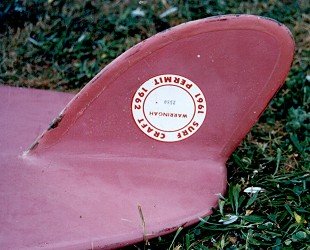
|
1959
D Fin
Laminated Timber ?
8 x 9 b @ 0 inches (Approximation)
Very ealy foam (polystyrene?)
Malibu board by
McDonagh Surfboards
Red 1961-2 Surfcraft
registration,
Warringah Council (Northern
Beaches), Sydney. |
|
|
|
1960
Roger
"The Duck" Keiran Fin and Wedge Finbox
Wood fin
11'' x 4 1/4'' base x 8'' span
(height
actually 13'' but allowance for fin box insertion).
Fin box,
fibreglass 7'' x 2 1/2'' and 1 1/2'' deep.
Note
that the fin base and finbox lengths are not
consistent and the fin maybe a replacement.
Images
courtesy of Mick Mock, Sydney Surf Auction 2010,
Catalogue #103.
|
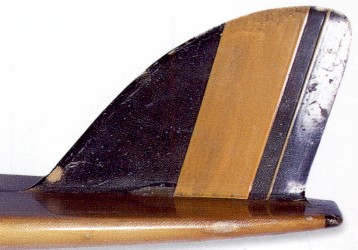
|
1960
Downing
Gun Fin
Wood and
fibreglass
10 x 8 b @ 2 inches
(approximation)
George Downing Surfboards,
Hawaii.
Ed and Randi Economy
Collection
"...one of ten shaped
by George Downing and was his personal board.
Stripes on fin were used to identify boards that
went out to sea as these were pre-leash days. This
was a common occurrence at Sunset beach in the early
1960 's."
Blackburn,
page 73
|
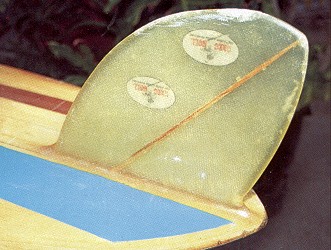
|
1960
Rounded D fin
laminated fibreglass
8 x 10 b @ 1 inches (Approximation)
Note in timber fin stringer and
decals.
Greg Noll Surfboards USA
Photograph :Don Blanch
LONGBOARD Magazine
Vol 4 No 5. 1996
November/December
page 68
|
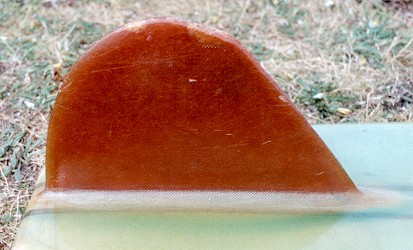 |
1960
Rounded D fin
Laminated chop-strand mat
Red pigment
Australia
8 x 10 b @ 1/2 inches
(Approximation) |
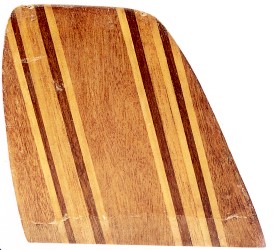
|
1960
Square fin
Laminated Ash and Walnut,
Fibreglass
8 x 8 b @ n/a inches (Approximation)
Cary B. Weiss Collection
Photograph : Douglas
Congdon-Martin
Schiffer
page
58.
|
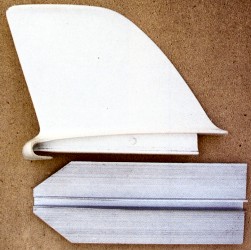
|
1960
Popout (Square) fin
Molded polypropelene
9 x 89b @ n/a inches
(Approximation)
Designed by Gerry Williamson
for Malibu Plastics, USA.
Aluminum box
The fin was removable, floated
and designed to release if heavy contact.
The design was
used in Australia by Dunlop Surfboards, circa 1964, see
below.
Photograph
:Uncredited
LONGBOARD Magazine
Vol 7 No 6.
November/December 1999 page 85
|
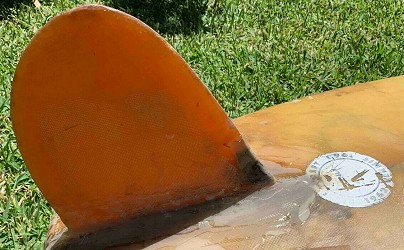
|
1966
Rounded D fin.
Gordon Woods
Surfboards
Manly Surf Permit 1962-1963
|
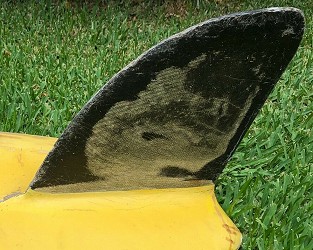
|
1962
D fin
Scott Dillon
Surfboards |
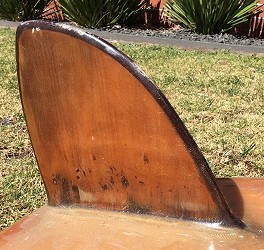
|
1962
D fin
The Surf Shop
Albert
House, King George Square, Brisbane, Phone 35-1012
Early 1960's restored 9ft 3" stringer-less
(!) with wooden D-fin,
about 8.5" deep. |
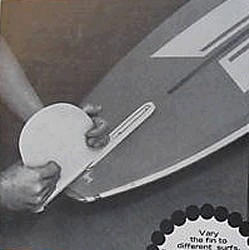
|
Brookvale - St Marys, Sydney
1962
Dunlop fin box, circa
1963-1966.
Vary
the fin to different surfs.
Remove it for easy
transportation.
Fin is held firmly in
position with specially designed nylon slot
attachment.
|
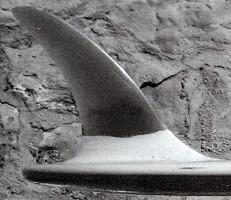
|
1960
Greenough
Laminated fibreglass, dimensions?
George Greenough's second
fin circa 1960, on a balsa kneeboard built
1959...
"wood shop at
school...the first flexible, high aspect ratio fin I tried."
Originally the board had
a conventional fin of the
period.
A Greenough Scrapbook
The
Australian Surfer's Journal,Volume 2 No 2, Autumn 1999, pages
82-84. |
 |
1962
Greenough Twin
Fins
Laminated fibreglass
Dimensions?
Photo: George Greenough; Crockett: Switch-foot,
page 175 |
The
(balsa spoon) board was built in 1962, originally as "a
twin fin, but as time went on, I moved the fins closer
together, and it kept working better and better.
Eventually,
it turned into a single fin!"
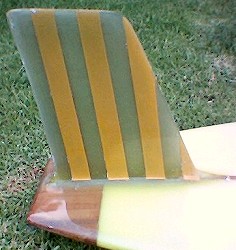
|
1963
Square Fin
laminated fibreglass,
yellow resin stripe decor.
JohnSaffron Surfboards |
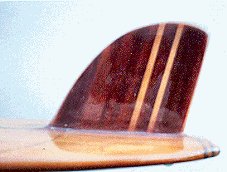
|
1963
D Fin
laminated red wood and balsa
with thin glass
bead.
8 1/4 x 10 b @ 2 inches
# 24
Balsa Malibu |
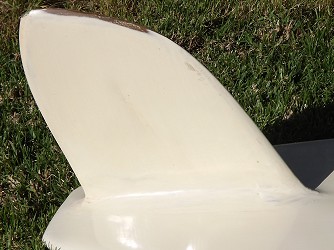
|
1963
Original gel-coated D fin
Keyo Surfboards.
Contributed by Graham in October
2019.
See Sutherland Shire Surf Craft Regulations,
1963.
|
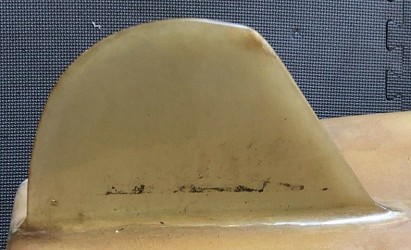
|
1963
Reverse D fin.
Scott Dillon
Surfboards
|
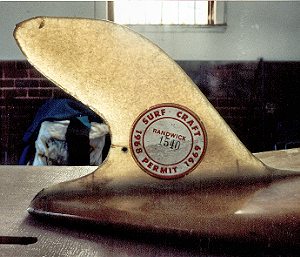
|
1963
Early Cutaway or Dorsal
or Dolphin fin.
Chop strand mat
9 1/2 x 12 b @ 0 inches
Surf Craft Sticker
Red Surfcraft permit
1968-1969 #1540.
Randwick Council (Southern
Beaches), Sydney
Crude fin with extended
base to tail.
#120
Shane Surfboards |
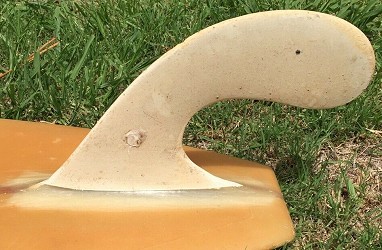
|
1963
Fathead
Laurie Hohensee: Safari
Surfboards
Mermaid
Beach, Gold Coast,
Queensland.
Also see Hohensee
Surfboards. |
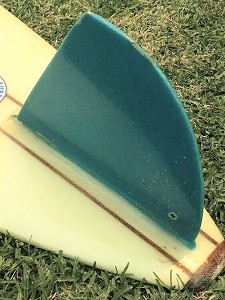
|
1963
Reverse
D.
Reverse- Phil- Pixie- Fin
Ron
Surfboards: Narrow (gun) tail).
Leg-rope hole.
|
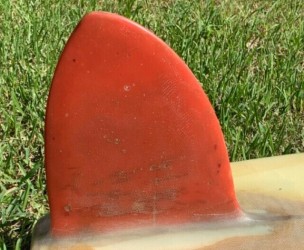
|
1963
Gothic
Fin
Gordon Woods Surfboards
Note leg-rope hole. |
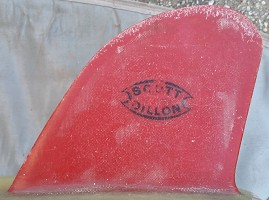
|
1964
D fin, Scott Dillon
Surfboards
Shaped by Bob 'Keno' Kennerson
Fibreglass
9 x 8 b @ n/a inches
(Approximation)
|
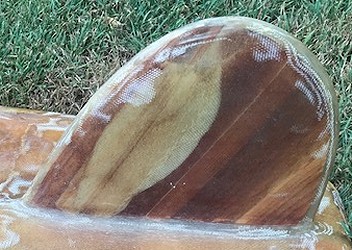
|
1964
Wooden D fin, Mick Dooley
Surfboards
Fibreglass and laminated wood panels.
9 x 8 b @ 1 inch (Approximation)
The white section is severe water staining.
Image thanks to Scott Wiggins, December
2019. |
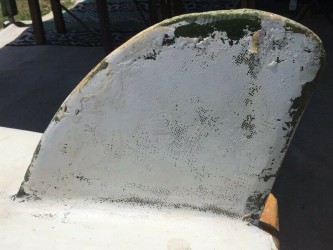
|
1964
Wooden D fin, Dale
Surfboards
Fibreglass, timber, and paint.
9 x 8 b @ 1 inch (Approximation)
|
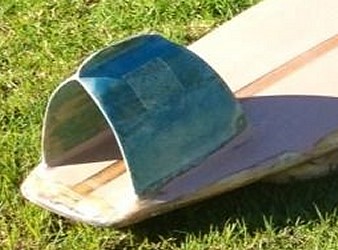 |
1964
Tunnel Fin
Sam
[Egan] Custom Surfboards - Merewether Surf Shop.
Laminated fibreglass
8 x 18 b @ 4 inches ??? (Approximation)
|
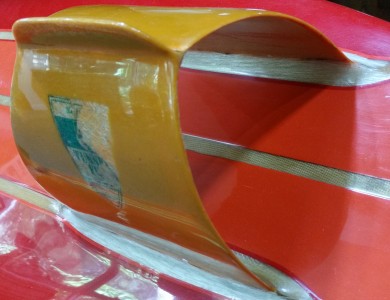 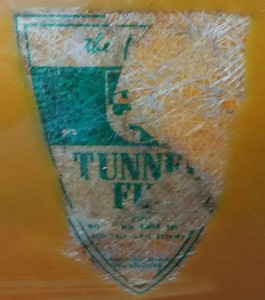
|
1964
Tunnel Fin
Sydney?
Images thanks to Snazzy, 2019.
|
|
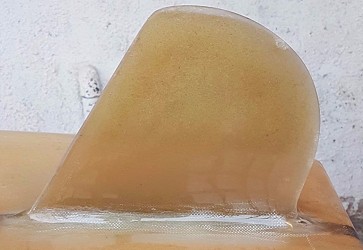
|
1964
Reverse
Rounded
D.
Reverse/Phil/Pixie Fin
Wallace
Surfboards
|
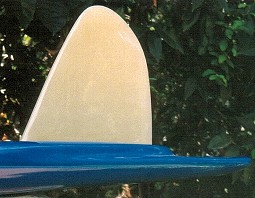
|
1964
Reverse
D.
Reverse/Phil/Pixie Fin
10 1/2 x
9 b @ 9 inches
Laminated
10oz cloth.
Set at
the tail step.
#190
King
Surfboards Step Tail |
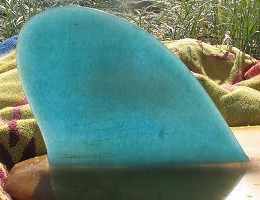
|
1964
Rounded D fin
9 x 19 b @ 2 inches (Approximation) |
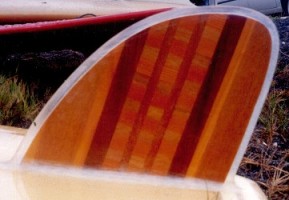
|
1964
D fin
Multi timber laminate
Resin Bead
9 x 19 b @ 2 inches (Approximation)
McDonagh Surfboards |
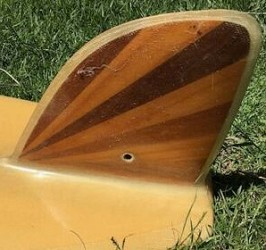
|
1964
D fin
Multi timber laminate - Sun
Beams
Resin Bead
9 x 19 b @ 0 inches (Approximation)
The hole in the fin could have been to hang the board for
display,
or less likely a leg-rope.
Bennett
Surfboards |
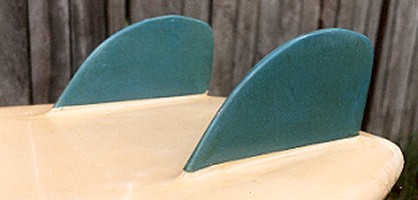 |
1964
Twin Keel Fins,
Pigmented chop strand mat
Minimal foiling
4 1/2 x 9
1/2 b @ 1 inches
# 50
Barry Bennett Surfboards Belly
board
, |
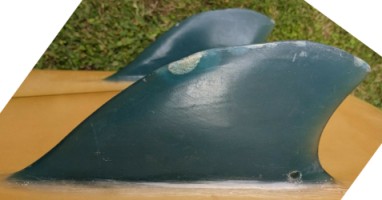
|
1964
Twin Keel Fins,
Light foiling
McDonagh Surfboards Belly board
|
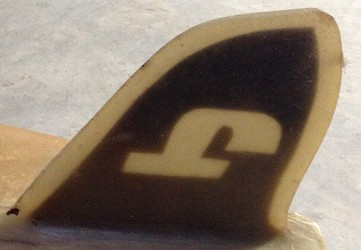 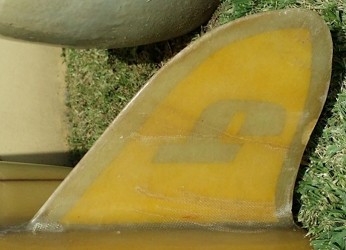 |
1963-19644
Jackson Surfboards J
Fin,
Laminated fibreglass
Minimal foiling
9 x 10
1/2 b x 13 1/22 s @ 0 inches
(estimated)
|

|
1964
Dorsal,
Laminated fibreglass
Deep foiling at rear near base
9 x 10
1/2 b x 13 1/22 s @ 3 1/2 inches
Barry Bennett Surfboards
, |
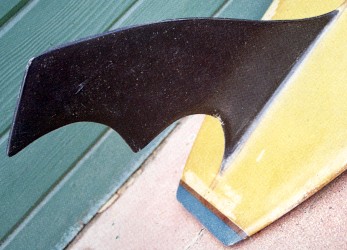
|
1964
Bat Fin
Laminated fibreglass
8 x 11 b @ 3 inches (Approximation)
Dave Sweet Surfboards USA
Photograph : Don Balch
LONGBOARD Magazine
Vol 4 No 5. 1996
November/December
page 70
|
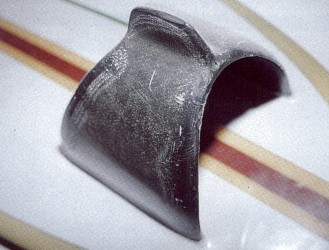
|
1964
Tunnel Fin
Originally by Richard
Deese.
-Thanks to Paul D.
Gross
Image - Hustler Fin
Laminated fibreglass
8 x 18 b @ 6 inches ??? (Approximation)
Ski & Dive (Surfboards) USA
Photograph : Don Balch
LONGBOARD Magazine
Vol 4 No 5. 1996
November/December
page 70
|
Australian Advertisment (from
unsourced clipping) circa 1965...
The Fabulous
Tunnel Fin
Bombora Surf Shop Box
2216 GPO Sydney
"The greatest
breakthrough in surfboard design since
the introduction
of the short board in 1956"
- Includes review by
Dennis Olsen
American Surf
Guide April 1964.
Cost by Mail Order
59/6 + 3/6 postage.
Aust. Patent :
435221/64
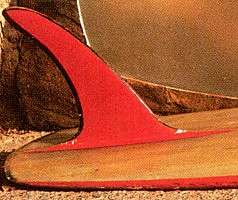
|
1964
Greenough
Laminated fibreglass,
Dimensions?
Velo Balsa Spoon
Fin circa 1964.
The board was built in
1962, originally as "a twin fin, but as time went on,
I moved the fins closer together, and it kept working
better and better. Eventually, it turned into a single
fin!"
George Greenough in
The Australian Surfer's
Journal
Volume 2 No 2 Autumn 1999, pages 84, 86 and 87. |
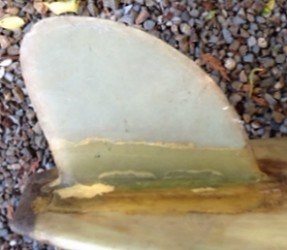 |
1964
D fin: Nat Young Model.
Gordon Woods Surfboards, 1964. |
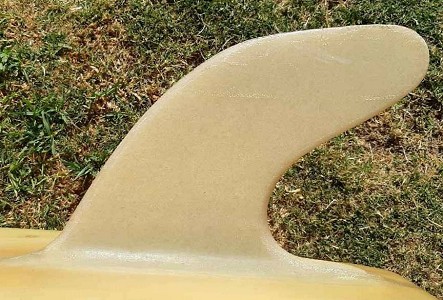 |
1965
Dorsal fin: Nat Young Model.
Gordon Woods Surfboards, 1965.
The board's owner suggested this was originally a
1964 D-fin that had been reshaped.
This is improbable, but note the straightened edge
at the top of the fin, evidence that the fin was
regularly ridden right to the beach, dragging in the
sand in the shallows.
|
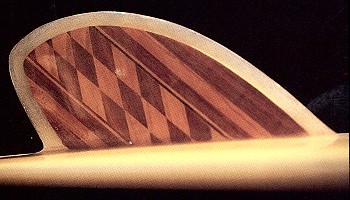
|
1965
Gun fin
Checkered timber laminate
with deep glass bead
7 x 13 b @ 8 inches (Approximation)
Flippy Hoffman's personal board
Dewey Weber Surfboards, USA
Photograph :Bjorn
DeBoer
LONGBOARD Magazine
Vol 4 No 5. 1996,
November/December, page 69
|
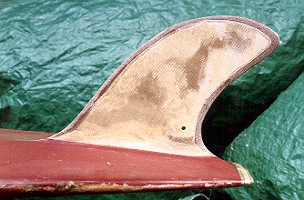
|
1965
Noserider (Nuuihwa
adaptation?)
Two colour laminated fibreglass
91/2 x 11
b @ 2 inches
# 87
Gordon & Smith (Australia)
Surfboards Noserider |
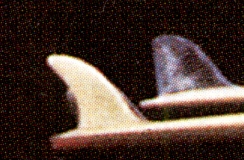
|
1965
Greenough Stage
I
Laminated fibreglass
10 x 7
b @ 2 inches (approximation)
First fin (left) by
George Greenough fitted to a conventional surfboard, early
1965.
The board (approximately 9 ft,
probably a Hayden) was shaped and/or ridden by Algie Grud.
The fin on the right is common
for the period.
Photograph & Notes: George
Greenough,
The Australian Surfer's
Journal ,Volume
2 No 2 Autumn 1999 page 105.
|
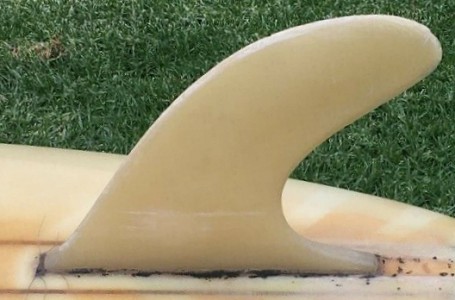 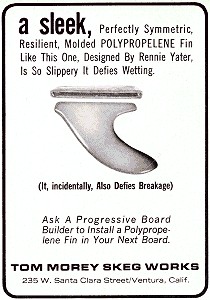
|
1965
Rennie Yater Fin by Tom
Morey's Skeg Works
Barry Bennett
Surfboard, 1965
Polypropylene
8 x 9 1/2 b @ n/a
inches (Approximation)
I assume the box was glassed into the board and the fin
then glued into place without rovings because the resin
would not bond to the Polypropylene.
Advertisement:
Tom Morey Skeg Works
235 W. Santa Clara Street,
Ventura, California.
Surfer
July 1965, Volume 6
Number 3, page 69 .
|
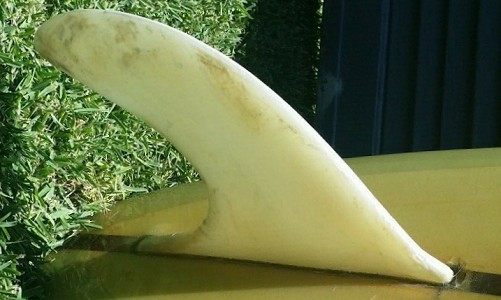
|
1965
Rennie Yater Fin by Tom
Morey's Skeg Works
Peter Clarke Surfboard, 1965.
Keith Paull Model
Polypropylene
8 x 9 1/2 b @ n/a
inches (Approximation)
|
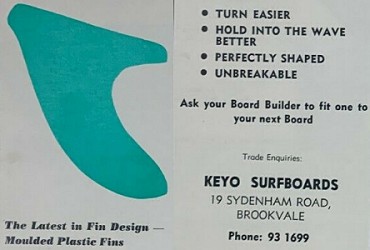
|
1965
Moulded Plastic Fin
Keyo Surfboards
Surfabout
v2 n12 1965 page 5 |
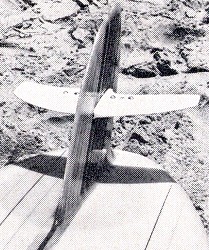
|
1965
Fin Stabilizer (on D fin)
???
8 x 9 1/2 b @ n/a
inches (Approximation)
One of several experiments
encouraged by Tom Morey's
Noseriding Contest at Ventura in July 1965.
Unaccredited.
Bill Cleary:
"Nose Riding - A sport
within a sport."
Surfer Magazine,
November 1965, Volume 6
Number 5, page 33.
|
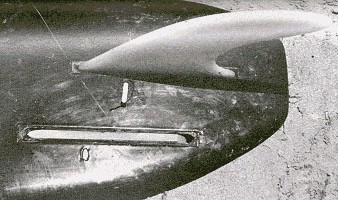
|
1965
Offset Fin Boxes (additional
control skegs)
Polypropelene
8 x 9 1/2 b @ n/a
inches (Approximation)
Another experiment encouraged
by Tom
Morey's Noseriding Contest.
Unaccredited.
Bill Cleary:
"Nose Riding - A sport
within a sport."
Surfer Magazine,
November 1965, Volume 6 Number
5, page 33. |
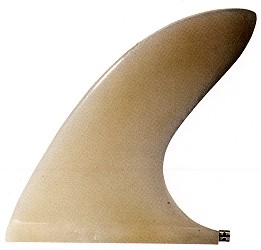
|
1965
Yater #2
Polypropelene
8 x 9 1/2 b @ n/a
inches (Approximation)
Note Wonder Bolt at fin base
- a stainless steel
capstan that tightened against the rear of of a fin
box.
C. R. Steck Collection
Photograph : Douglas
Congdon-Martin
Schiffer
page
59.
|
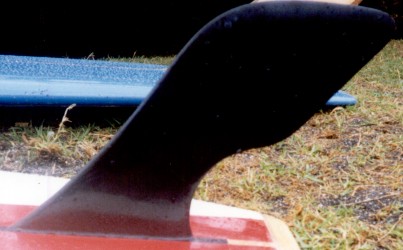
|
1965
Hatchet fin by Weber
7x 11 b @ 5 inches
(Approximation)
Weber Performer
Dewey Weber Surfboards USA
The Hatchet Fin was designed
by Dewey Weber in 1965 with the original
template at a massive 18 and was called the Turn
Fin, before adopting the name Hatchet Fin.
The design became
synonymous with Dewey Weber Surfboards Performer model.
|
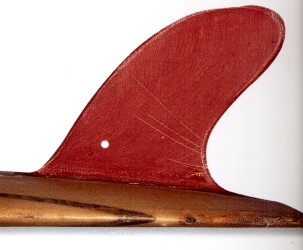
|
1965
Hynson Dorsal - Red
fin
Laminated fibreglass
9 x 9 b @ 4inches (Approximation)
Gordon and Smith Surfboards USA
Alan Seymour, Pacfic Coast
Vintage Auctions
Blackburn,
page 228
|
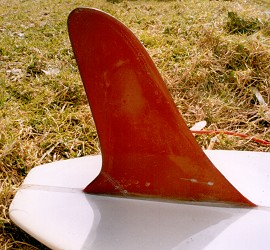
|
1965
Straightback
Laminated fibreglass
10 1/2 x 10 1/2 b x 10
1/2 s @ 4 inches
Scott Dillon Surfboards |
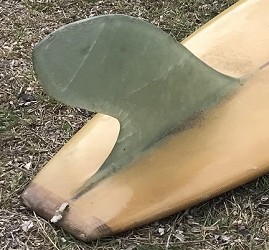 |
1965
Cooper Fin
Laminated fibreglass
10 x 10 b x 10s @ 2
inches
Max Gill Surfboards
Possibly attributed to Bob Cooper.
|

|
1965
Waveset range of fin
designs.
|
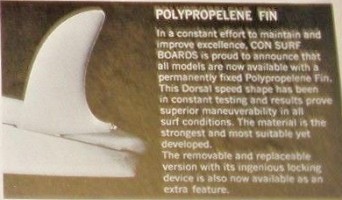
|
1966
Dorsal
Fin- Wonder Bolt
White
polypropelene.
Con Surfboards, Santa Monica, California.
Surfer, January 1966
Volume 7 Number 6
|
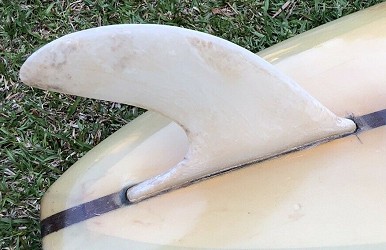
|
1966
Nylon
Dorsal - Dolphin
Keith
Paull Model
Peter Clarke
Surfboards.
|
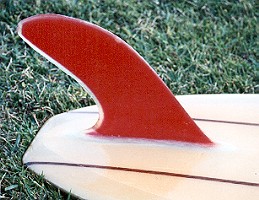
|
1966
Dorsal
- Dolphin
Red
pigment laminated fibreglass.
9 x10 b @
3 inches.
Slight
foiling to rear edge.
Australian
copy of Hynson Dorsal (Red Fin)
Gordon
and Smith Surfboards USA
#169
Barry
Bennett Surfboards |
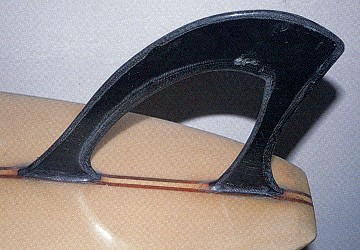
|
1966
Flow-thru Fin
Laminated fibreglass
10x 10 b @ 1 inches ??? (Approximation)
White Owl Surfboards USA
Photo: Don Balch
LONGBOARD Magazine
Vol 4 No 5. 1996
November/December
page 70
|
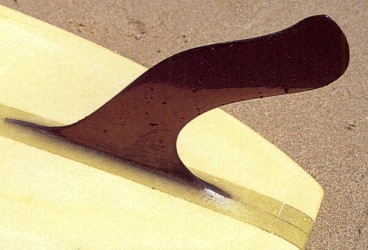
|
1966
Tiger tail fin
Laminated fibreglass
12 x 8 b @ 5 inches (Approximation)
Tiger Espere
Greek Surfboards USA
Photo: Don Balch
LONGBOARD Magazine
Vol 4 No 5. 1996
November/December
page 70
|
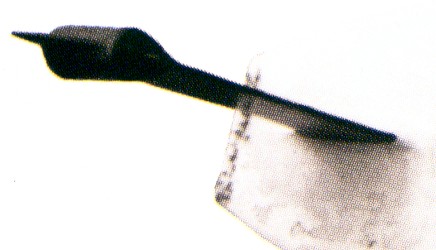
|
1966
Weber Turbo Fin
Laminated fibreglass ?
11'' x 5'' b @ 4
inches (Approximation)
Factory Powered by Weber
Noserider Model
Weber Surfboards USA
Image cropped from
Warshaw
: Surfriders page 77
Photograph by Leroy Grannis
|
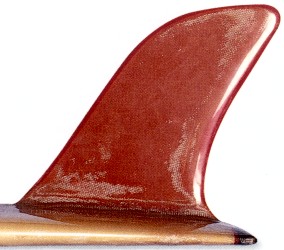
|
1966
Nuuhiwa Noserider Fin
Laminated fibreglass
8 x 10 b @ 2 inches (Approximation)
Nuuhiwa Noserider
Model
Bing Surfboards USA
Hoffman Collection
Blackburn,
page 130
|
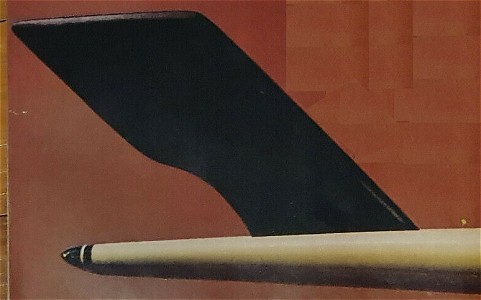
|
1966
Weber Hatchet Fin
Dewey Weber Surfboards : Performer.
Surfer, May 1966, Volume 7 Number 2,
page 14.
|
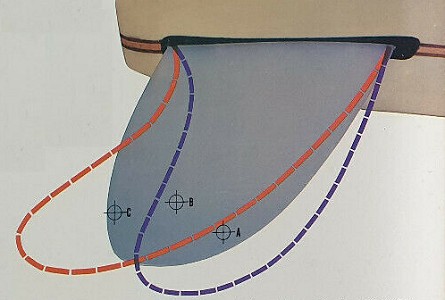
Surfer,
Volume 7 Number 3, July 1966, page 1.
|
1966
Hobie Interchangeable Fin
Fin "A" (easy turn fin) - the board
will turn easier with less effort, especially good for
small surf and the surfer who turns a little further
forward on his board.
Fin "B" (standard HOBIE) - good
all-around fin which gives good positioning for
conditions not suiting Fins "A" or "C."
Fin "C" (speed fin) - this fin is not correctly named,
as it does not enable the board to go faster, nor does
it make the board slower.
The speed fin allows for more powerful turns from
further back positioning on the board.
This is an excellent fin for larger waves and
whip turns.
Further experimentation may be carried out by
reshaping any one of the above fins.
|
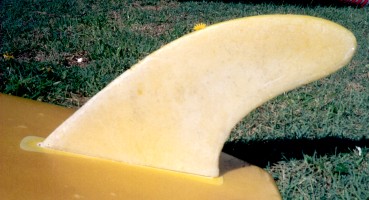
|
1966
Hobie Bolt-Thru
Molded Polypropylene
10 x 10 b @ 1 inches ??? (Approximation)
Removable fin that is fixed by
a bolt in the deck.
Precursor to to Tuttle
Sailboard fin box system.
Corky Carroll Flexible
Model
Hobie Surfboards USA |

|
1966
da Cat fin
Molded ABS
8 x 8 b @ n/a inches (Approximation)
Micki Dora da
Cat Model
Greg noll Surfboards, USA
Base tounge and indent to lock
into corresponding fin box.
C. R. Steck Collection
Photograph : Douglas
Congdon-Martin
Schiffer
page
58
|

|
1966
Dunlop replaceable fin and slot-box.
Vary
the fin to different surfs.
Remove
it for easy transportation.
Fin
is held firmly in position with specially
designed nylon slot attachment.
Surfing World
Volume 8, Number 4, November, 1966 |

|
1966
Greenough
Laminated fibreglass
10' x 8" base
Velo SS MKII fin 1966.
10' x 8" base
Photograph? and Notes:
Paul Gross:
"Far-out Flexible Surfboard
- Wave of the Future ?"
The Australian Surfer's
Journal
Volume 1 No 4 Spring1998 page
18. |
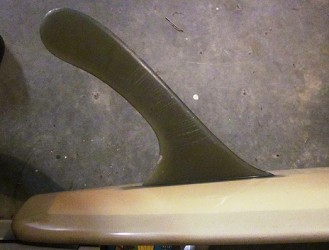
|
1966
Midget Farrelly Fathead
12
1/2" x 8" base @ 7 1/2'',
Laminated
fibreglass.
Catalogue #00000350
Photograph by Garry Crockett,
with thanks.
Midget was supplying a
variation on this design in 1995.
See below.
|
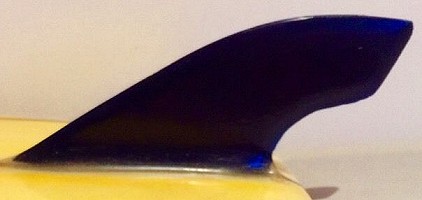
|
1966
Wedge Special Kneeboard
California
|
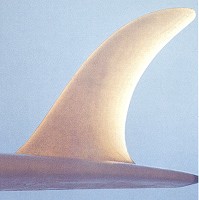
|
1967
Greenough
Laminated fibreglass
Dimensions?
Surfboard flex fin 1967.
Board shaped?/ridden by
Danny Hazard.
Photographs : Al Lees,
Notes : George
Greenough.
Moving Forward
A Greenough Scrapbook : 1960
- 1970
The Australian Surfer's
Journal
Volume 2 No 2 Autumn 1999 page
73. |
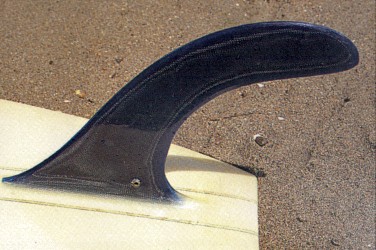
|
1967
UFO
Laminated fibreglass
12 x 7 b @ 5 inches (Approximation)
Rick Surfboards, USA
Photo: Don Balch
LONGBOARD Magazine
Vol 4 No 5. 1996
November/December
page 70
|
 |
1967
G &S High Performance
(Skip Frye)
Gordon and Smith Surfboards,
USA.
With
much experimenting and testing with the fin, the High
Performance low area fin evolved.
In March, it made it's debut on the Skip Frye Model
and was available at no extra cost on most of our
other boards.
Surfer, November
1967, Volume 8 Number 5, page
4.
|
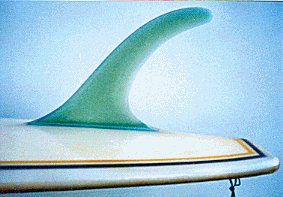
|
1967
G &S Hy-Performance
(Mike Hyson)
Gordon and Smith Surfboards,
USA
- thanks to Paul D. Gross
Laminated fibreglass
11 1/2 x 11 b @ 9 1/2
inches
# 26
Gordon and Smith (Australia)
Vee Bottom |
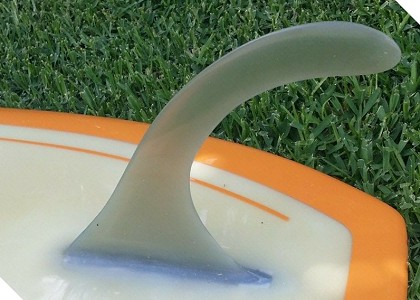
|
1967
G &S : Bobby Brown
Stingerless
Gordon
and Smith Surfboards, Caringbah |
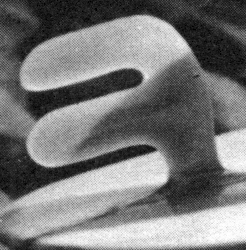
|
1967
F fin
Laminated fibreglass
12 x 4 b @ 9 inches (Approximation)
Richard Harvey (Crusader
Model?)
Ron Wade Surfboards ?
Richard Harvey interview
Surfing World Volume
11 Number 1 1968
Margan
and
Finney, page 167
|
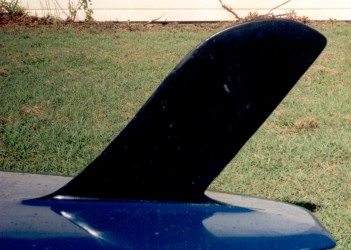
|
1967
Eliminator fin
Laminated fibreglass
12 x 7 b @ 6 inches (Approximation)
Eliminator Model
Greek Surfboards
USA |
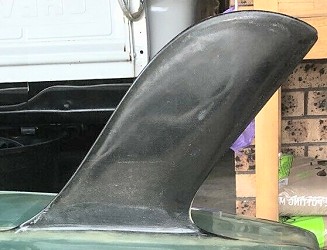
|
1967
Eliminator by Greek- Hatchet
fin
|
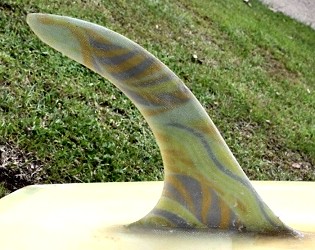 |
1967
Greenough Stage III
?
Multi-colour fibreglass
laminate
13 1/2 x 8 b @ 9 1/2
inches
George Rice Surfboards
Stringer-less V-Bottom
7ft 8" x 24"
Pod: 16" |
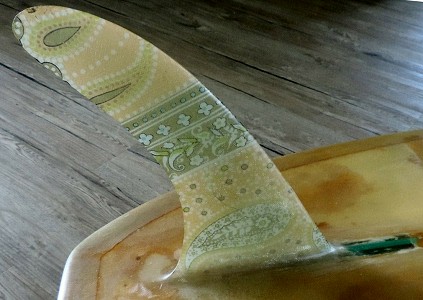
|
1967
Greenough Stage III
?
Fabric laminate
Kenn Surfboards, Gary Birdsall
shape.
Although the board is probably from 1966, this fin appears
to be a later replacement, hence dated 1967.
Note the deep rail-lap cut.
|
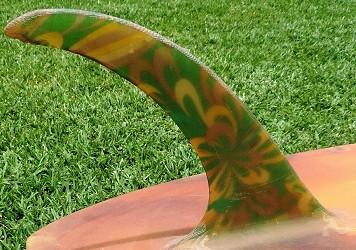
|
1967
Greenough Stage III
Floral fabric laminate
Hawke Surfboards, Western
Australia.
Stringer-less V-Bottom,
marked LP4149.
|
|
1967
Fins Unlimited
Fin and Finbox
The first version of Fins
Unlimited (with Chase Parker Bahne,
1967) removable moulded fin and fin
box
The
fin is fixed by a rear bolt only.
11'' x 10'' base x 12'' span @
9.5'' .
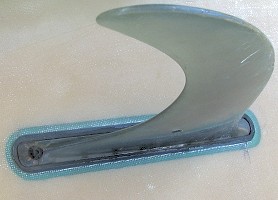
|
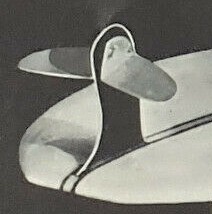
Surfer, July 1967, Volume 8 Number 3, page 21. |
1967
Fin Foil
Karl Ekstrom Co., La Jolla, California.
It'll turn your board into a Noserider!
The FIN-FOIL* lifts the nose for
noseriding it stabilises the board for powering
through soup it can be adjusted to the degree of
noseriding you prefer it has rounded edges for the
greatest safety made of high temper aluminum,
anodised in a mellow gold finish for durability
against weathering foils can be easily removed
comes complete with solid brass fittings and easy
instructions for attaching. Only $8.50.
|
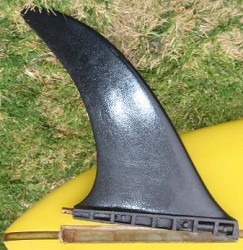
|
1968
Wonder Bolt and fin box
Weber Surfboards, USA.
|
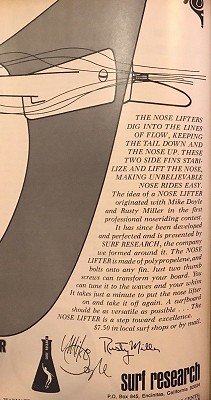
|
1968
Nose-Lifter by Surf Reseach
Mike Doyle - Rusty Miller
International Surfing
January 1968
Volume 3 Number 6, page ?
Surf Research was
Californian company producing a range of products
from the mid-1960s, including their coloured and scented
surf wax, Waxmate.
The
principals were Garth Murphy, Mike Doyle, and Rusty
Miller.
Doyle
and Miller were outstanding surfers,with substantial
competitive careers and regularly appearing in
magazines.
At the end of 1960s the Californian company was sold and Mike Doyle relocated to Mexico, Rusty to Kauai, and Garth Murphy emigrated to
Australia where he marketed Waxmate from a post box in
Byron Bay, circa 1970.
In the
early 1970s, Rusty Miller and his wife Tricia Shantz also
relocated to Australia and
they currently reside in Byron Bay.
Rusty
contributed to John Witzig's ground breaking Tracks
and featured in the Bali sequences of Albert Falzon's The
Morning of the Earth.
|
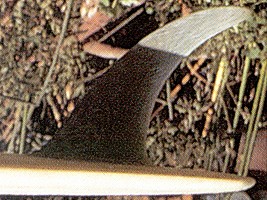
|
1968
Greenough
Laminated fibreglass
Dimensions?
Surfboard flex fin
1968.
Board shaped by George
Greenough,
ridden by Terry
Keys.
Probably Wilderness
Surfboards.
Photograph and Notes :
George Greenough, The Australian Surfer's Journal
Volume 2 No 2 Autumn 1999 page
72. |
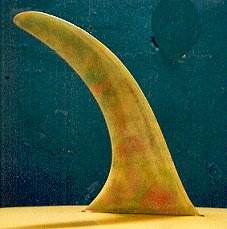
|
1968
Greenough Stage III
?
Dappled fibreglass laminate
13 1/2 x 8 b @ 9 1/2
inches
#107
WM Surfboards Pin Tail Vee
Bottom |
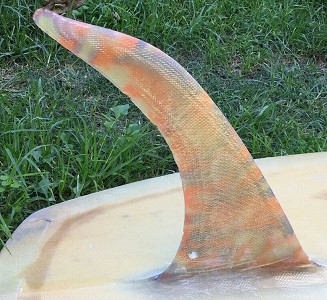
|
1968
Greenough Stage III
?
Dappled fibreglass laminate
Wallace Surfboards.
Note leg-rope hole and the fin tip has been worn down by
riding the board through wet sand in shallow water.
|
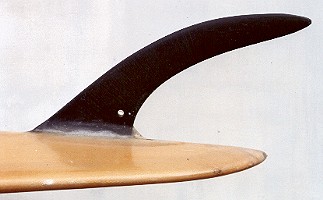
|
1968
Finger fin
Fibreglass laminate
9 x 6 1/2 b @ 9 1/2
inches
#111
Scott Dillon Pin tail
Probably not the original fin. |
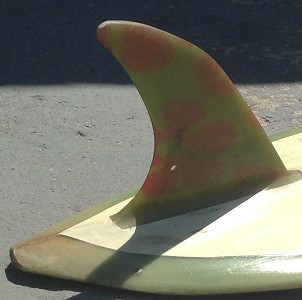
|
1968
Wide-base
fin
Dave Jackman Plastic Machines
(Surfboards)
Auckland,
New Zealand.
Dappled fibreglass laminate
Deep-vee pintail |
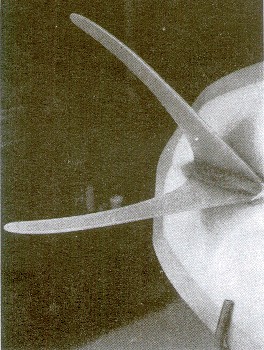
|
1968
Butterfly fin by Scott
Dillon
Fibreglass laminate
Estimation: 9 x 6 1/2 b @ 9
1/2 inches
Scott Dillon convex bottom,
ridden by Dr. Robert Spence.
Also tested by Nat Young and
Bob Kennerson
Surfing World
Volume 10 Number 4,
March-April 1968, page
43.
|
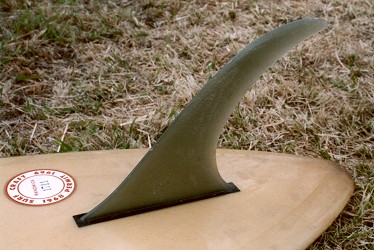
|
1968
Flex fin
Fibreglass laminate
10 1/2 x 9 1/2 b x 15 s @
10 inches
#303
Hayden Surfboards Pin tail
Internal rovings. |
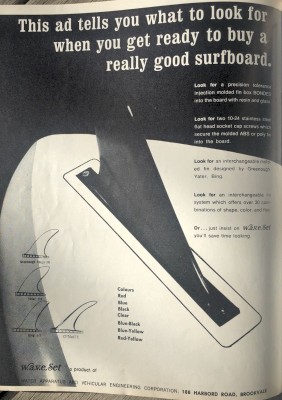
|
1968
[Bennett Surfboards]:
WaveSet Advertisement
Look
for a precision tolerance injection molded fin box
bonded into the board with resin and glass.
Look for two 10-24 stainless steel flat head socket
cap screws which secure the molded ABS or poly fin
into the board.
Look for an interchangeable molded fin by Greenough,
Yater, Bing.
Look for an interchangeable fin system that
offers 30 combinations of shape, color and flex.
Or just insist on W.a.v.e. Set .. and save time
looking.
Colors: Red, Blue, Black, Clear,
Blue-Black, Blue-Yellow, Red-Yellow.
Designs: Greenough Stage III, Yater #2, Bing #1,
O'Neill #1
W.a.v.e.
Set
A product of Water Apparatus and Vechicular
Engineering Corporation
188 Harbord Road Brookvale
Surfing World September
1968, Volume 11 Number 3 page. |
Clear as the sea around
us!
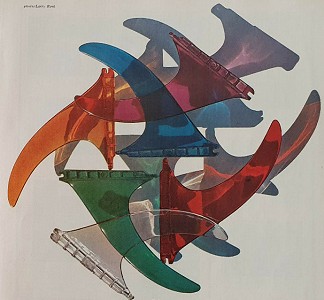
Introducing our Phase III mini
fin.
Designed to allow controlled tail drift and radical nose
rides.
It measures 6" deep, has an area of 22 square inches and
weighs 150 grams.
It too is made of transparent Lexan.
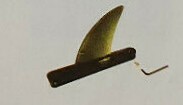
|
1968
Fins Unlimited
Advertisement:
Here they are.
Six totally new color additions to the Fins Unlimited
Line.
Clear as crystal.
With colors of the rainbow.
More beautiful than anything that has come before.
Made from a unique transparent plastic called Lexan.
So strong it virtually defies breakage, more durable than
any fin on the market today.
But beyond its uniqueness and beauty ... a function in
design.
Functionally designed.
Designed to compliment the riding capabilities of
contemporary surfboard design.
Designed to fulfil your most crucial demand.
We offer these fins with our removable fin assembly,
consisting of a high strength channel bonded into the
surfboard into which the fin is held securely by a nylon
crosspin in the front and a 1/4" 20 stainless steel socket
head bolt in the rear Combined win a tacking taper to
eliminate all play in the assembly.
We create so that you may be creative.
Fins
Unlimited
PO Box 161, Del Mar, California.
Surfer, Volume 9
Number 5 page 35, November 1968.
|
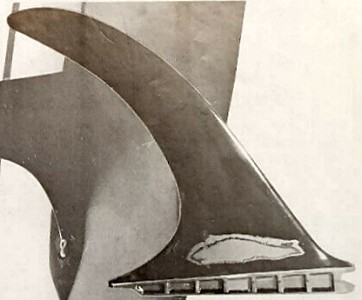 |
1968
The Removable
A revolutionary detachable fin system by
Atlas/Woods.
Removable
bolt-on fins in translucent colours, opaque black, or
clear I.P.C.
Atlas/Woods
Surfboards
Wairau
Road, Tapapuna, Auckland, 9.
Depth: 11"
Base: 10"
Camber: 13"
Area: 40 in.
(squared)
Weight: 14 1/2 oz.
See: Allan Byrne : Puerto
Rico.
Surfing New Zealand Volume 1 Number 1
December 1968.
Probably the Fins
Unlimited design above.
|
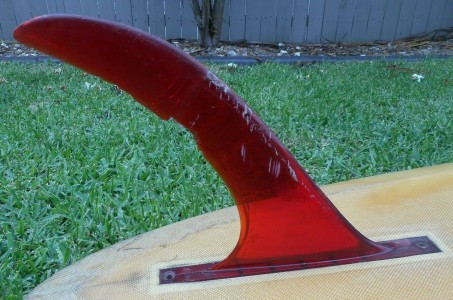
|
1969
WaveSet: G &S
Hy-Performance (Mike Hyson)
Bennett Surfboards.
Reportedly: At some point the fin was
broken in half and been glued back together.
|
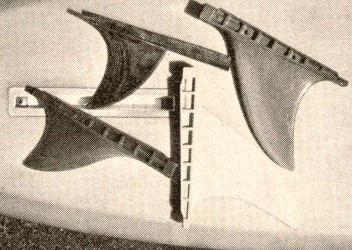
|
1969
Waveset: Skipp Frye's
New-e-free fins
Waveset fin box (?)
Surfing, circa
1969, page 31. |
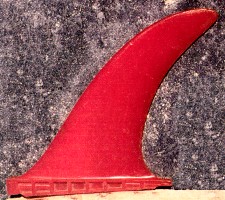
|
1969
Greenough Stage
III - Wave Set
Laminated fibreglass , Dimensions?
Moulded: tapered wedge base,
fixed by two screws, into nuts set in the moulded
box.
Greenough Stage IV by
Wave Set Fins, circa 1970.
Photograph : George
Greenough, Notes :
Paul Gross
Australian Surfer's Journal
Volume 2 No 2 Autumn 1999 page
73. |
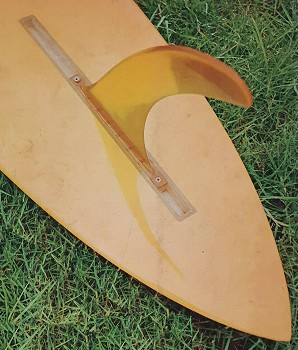
|
1969
S.A.F.E Set Fin Systems
The fin is the most important part of a surfboard.
All manoeuvres are dependent on
the fin for successful surfing.
A fin moved forwards or backwards a small
distance will alter the performance of the board.
S.A.F.E. set fin systems have now introduced
after many months of testing a sliding
fin system.
Now for the first time it is
possible for you to experiment by moving the fin
forward or backwards to suit yourself.
See for yourself the difference fin positions
make to your surfing by ordering one on your next
board.
S.A.F.E. set fin
systems, clear or coloured, shatterproof,
replaceable poly-carbonate fins.
19
Sydenham Road Brookvale 93 6699.
Surfing World
Volume 12 Number 1 1969.
The address was the same as Keyo
Surfboards.
|
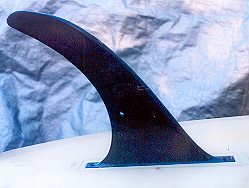
|
1969
Safe Set Fin (Large) and
Box
Moulded Plastic
11 x 8 1/2 b @ 10
inches
#69
Keyo Tracker |
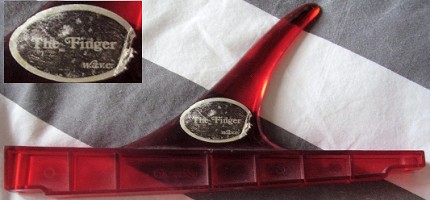
|
1969
-1970
Waveset The Finger
Fin
Moulded Plastic
Decal image forwarded by Robyn, with
thanks, April 2014.
|
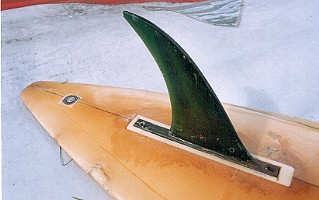
|
1969
Safe Set Fin (Small) and Box
Moulded Plastic
8 1/2 x 7b @ 9 1/2?
inches
Possibly re-shaped
#67
Surf Design Mini Gun
Dick van Straalen |
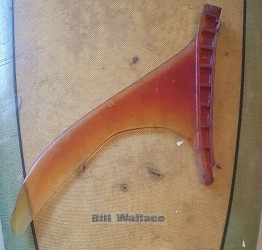
|
1969
Warped SafeSet or Wave Set
Fin
Moulded Plastic Bill Wallace
Surfboards.
|
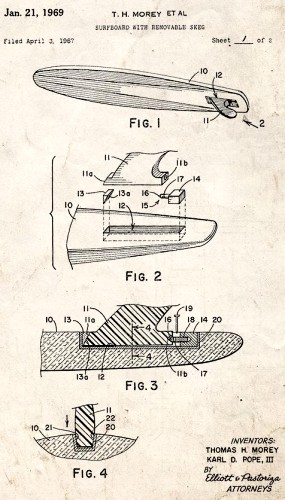
|
1969
Thomas H. Morey and Karl D.
Pope III:
Patent: Surfboard
with removable skeg, 21 January 1969.
Note
Numbers 17-19: appears to be for a similar design to the
Wonder Bolt system.
|
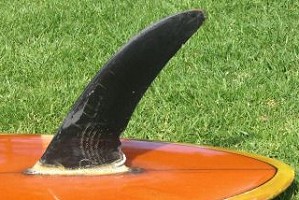
|
1969
Farrelly Surfboards |
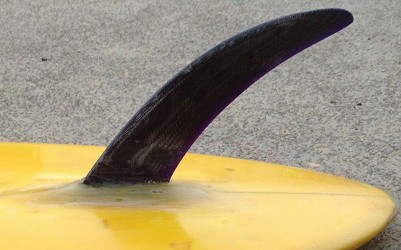
|
1969
Farrelly Surfboards: Speed fin. |
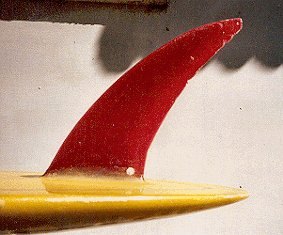
|
1969
Egg Pivot Fin
8 1/2 x 4 1/2 b @ 5
inches
#45
Geoff McCoy Egg
Keyo Surfboards |
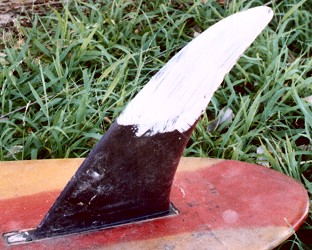
|
1969
Side Slipper Fin and
Box
8 3/4'' x 6'' b @ 6
1/2 inches
Molded
black plastic
Notched
Fin box with plastic clip lock
#217
Side Slipper
Keyo Surfboards |
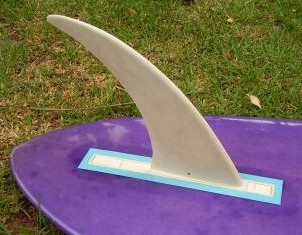 |
1969
Adjustable fin and fin box
with fore and rear locking clips.
Burfrord Surfboards, South
Australia.
Contributed, with thanks by
Mike Brown, Adelaide, January 2007.
Mike noted
The Burford fin box and fin
has no stampings.
I reckon Don had these made
up.
My Arnold/Lynch boards which
have the same set-up are identical,
but some fins have 'Made in Australia', others haven't. |
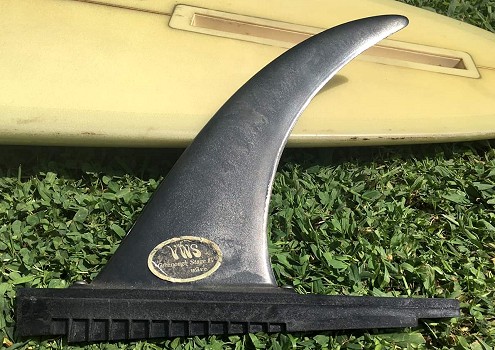
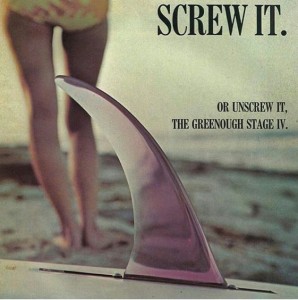
Surfer, Volume 10 Number 4, September 1969.
|
1970
Greenough Stage IV: VWS- Variable Wave Set Fin
and Box
Adjustable
(two screw) George Greenough Stage IV by WaveSet.
Images thanks to
snazzy, January 2019.
|
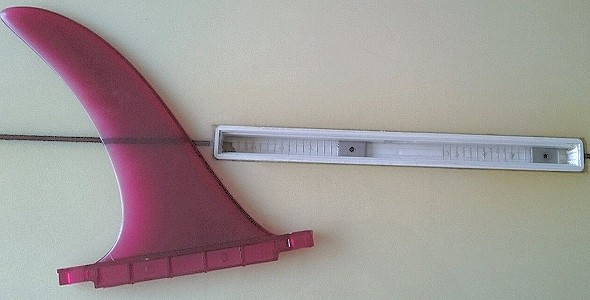 |
1970
Vari-Set by Waveset Fins,
Newport Paipo Boards, California, 1970 |
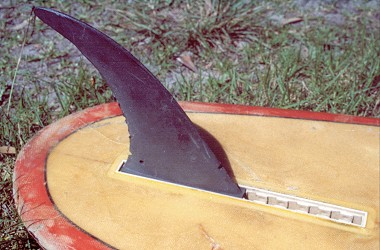 |
1970
Adjustable
Fin and slotted wedge fin box.
Fin : 8
1/2" x 6''b x 9 1/2'' span
Black,
molded "glass filled nylon".
Rear
post-production legrope hole.
Finbox :
12'' @ 5 1/2''
Image
below.
When new, the system used several plastic
locking clips that filled the exposed section, see above.
The fin
and box probably manufactured by Simplex Fins, South
Australia.
Advertising
image and text below.
Probably
copied from a Waveset (USA) design circa 1968.
The
design was short lived and was replaced with the
universally adopted Bahne box. |

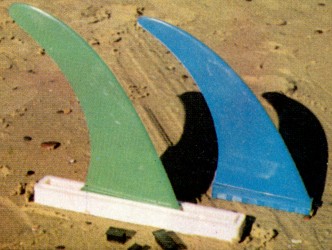 |
1970
Simplex
I Fin system.
"No
bolts, keys or any hardware.
So
simple, the fin can be changed in seconds.
The
precision box allows
six
positions over a five inch adjustment span.
Three
fin shapes in glass filled nylon,
colours
green, blue, red, yellow, white and black.
SIMPLEX
Fin Systems
142
Gawler Place, Adelaide, 5000 Phone 23 5505"
Surf
International
Volume 3
Number 3, circa 1970, page 2. |
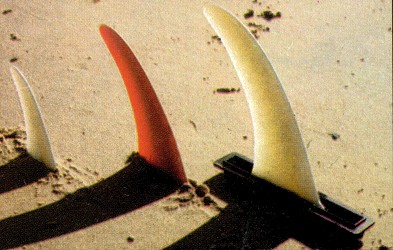  |
1970
Simplex
II Fin system.
SIMPLEX
Fin Systems
142
Gawler Place, Adelaide, 5000 Phone 23 5505"
Surf
International
Volume 3 Number 3, circa 1970, page 2.
Ad: Tracks, May 1971.
|
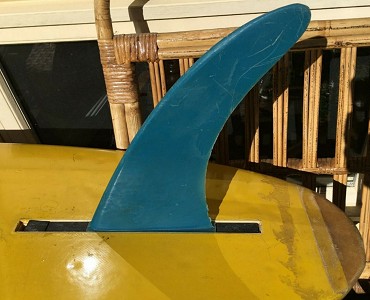
|
1970
Simplex
Fin system with box-plugs.
Fat Albert
- John Arnod Surfboards, Adelaide. SA.
JA's low cost pop-out model, similar to the Shane Standard
and the Wallace Junior.
One example:
5'6" x 20" x 3" in yellow pigment and
unusually fitted with a Simplex fin-box with
box-tabs, said to be an idea of Wayne Lynch. |
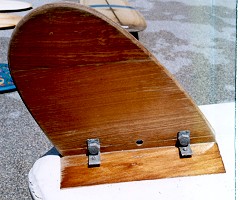
|
1970
D fin - Coolite Timber
Adaption.
Timber |
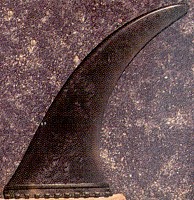
|
1970
Greenough Stage
IV - Wave Set
Moulded, Dimensions?
Segmented base that slotted
into a moulded box and fixed by clips.
See Twin fin I 1971, below..
Greenough Stage IV by
Wave Set Fins, circa 1970.
Photograph : George
Greenough, Notes :
Paul Gross
A Greenough Scrapbook : 1960
- 1970
The Australian Surfer's
Journal
Volume 2 No 2 Autumn 1999 page
73. |
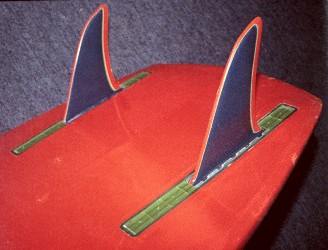
|
1970
Guidance Fin System : Twin
fin I
Unknown construction
5 x 7 b @ n/a inches (Approximation)
Note the symmetric foil.
Photo: Don Balch
LONGBOARD Magazine
Vol 4 No 5. 1996
November/December page
70
|
Paul D. Gross reports,
with thanks...
Guidance System fin boxes
circa 1970.
A copy of Wave Set's adjustable
system using a segmented or notched base with the fin held by
moulded plastic clips.
Both systems were to be rapidly
replaced by the Fins Unlimited ( Bahne) system, circa
1971."
|
1970
Keyo Twin fin in
Fin-boxes
Below:
Fin-box and Fin Tabs on the base.
|
1970
Bill Barnfield's Fins Unlimited
Finbox
The design rapidly becomes an industry
standard, and is still in use in modern Malibu boards and
sailboards.
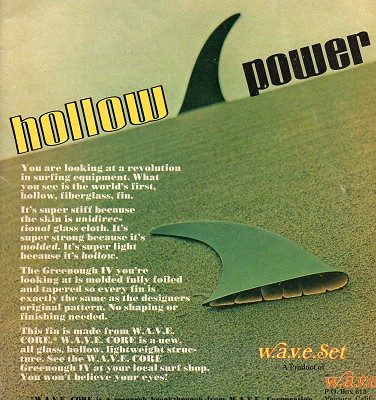
|
1970
WaveSet: Hollow Greenough IV
Surfer: First
Annual End of the World Issue.
Volume 11 Number 2 page 2, May 1970
and page 9:
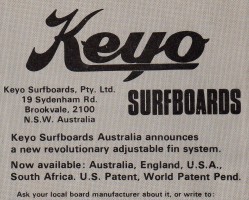 Keyo Surfboards: Fin
Box
Keyo Surfboards: Fin
Box
|
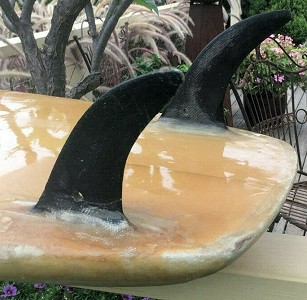 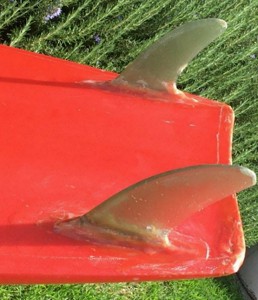 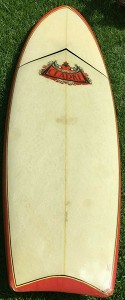
|
1970
Twin Fin 1
Fibreglass
a. Ron Wade Surfboards
b. Peter Clarke Surfboards
Note:
Both boards have holes drilled through the fins for
attaching a leg-rope.
The difference in the fin shapes
The unusual scooped-chamfered tail on the Clarke,
regularly used on wide tail vee-bottoms in 1967-1968.
|
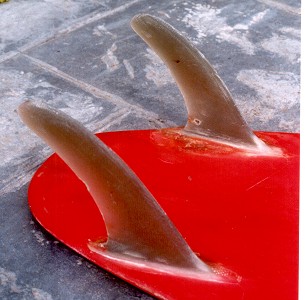
|
1970
Twin Fin 1
Fibreglass
Left : 6
1/4 x 4 b @ 5 1/2 inches.
Right : 6
3/4 x 4 b @ 5 1/2 inches.
Clear
laminate with fin patch
High
aspect Greenough
Toed in
to nose, but tip-out not symmetric, probably due to
non-expert repairs
Note the
fins, probably original, have been heavily damaged,
possibly trimed and reinforced.
#134
Farrelly
Surfboards |
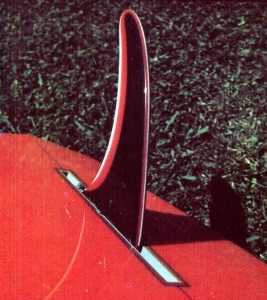
|
Farrelly
230
Harbord Road, Brookvale 2100, NSW, Phone
939-1724.
This
is the first removable, sliding
fibreglass fin unit in Australia.
It
can be found on Farrelly surfboards, Midget has
always preferred glass
fins
refusing to install substitutes and he has this
patented system that will
revolutionize
fin
systems all over the world.
This
fin system is installed in new boards at no extra
cost.
Surfing
World
Volume
13 Number 5, circa May-June 1970, page 39
|
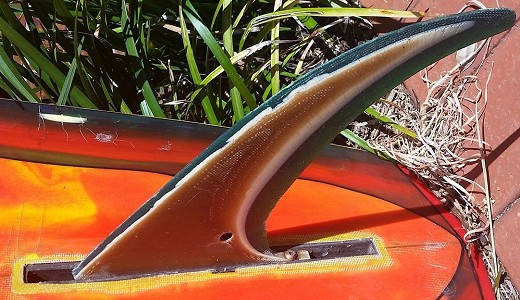 |
1970
Farrelly Fin and Finbox |
|
1971
WaveSet II - fin and box,
and clips.
Images courtesy of
Bob Groves and Alex Williams,
2018.
Alex noted:
Thought you might appreciate these shots of WAVE
set MK 11 from 1971? ish.
They where from a UK board maker Bob Groves who
shaped boards and blew foam from mid 60s on.
Now in his mid 80s he is passing on some of the things
that have been stored for years.
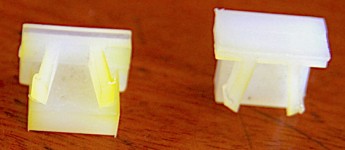 WaveSet clips.
WaveSet clips.
The clips helped to
lock the fin in the base and they closed the gap,
theoretically to reduce turbulence.
|
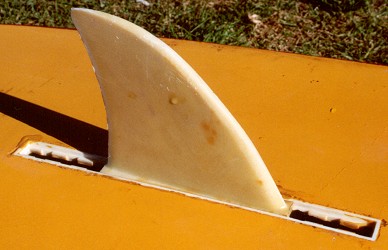
|
1971
Surf ski fin and fin box
Fin features a segmented base
that slots into a molded box, and clicks back to lock.
This example is missing the
plastic clips that close the slot.
Australian version of the Guidance
Fin
System - see above.
Molded plastic.
5 1/2'' x 6'' b x 0'' span @
n/a inches
Symmetric foil. |
 |
Image right -
male notched fin base.
Close up fin base,
note MADE IN AUST. |
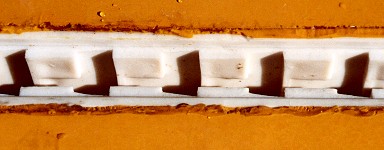 |
Fin box 12
inches.
Image left - molded
female box
Close up of slots in fin box. |
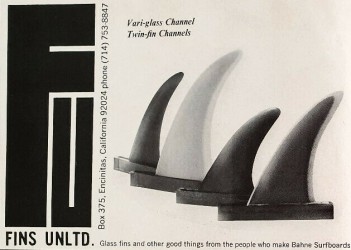
|
1971
Fins Unlimited:
Vari-glass Channel and
Twin-fin Channels
Glass fins and other good things from the people who
make Bahne Surfboards.
Surfer
March 1971
Volume Number page 4. |
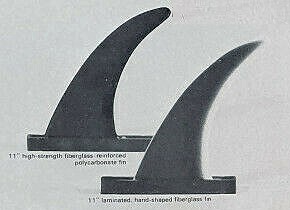
|
1971
Fins Unlimited:
There are two types of fiberglass fin.
The laminated, hand-foiled custom, and the molded
Vari-glass.
We make both. Why?
The laminated, hand-shaped, fiberglass fin allows
us to experiment with new shapes, foil sections and
flex patterns before the fin is put into production,
using Vari-Glass, a high-strength,
fiberglass-reinforced polycarbonate resin.
Using Vari-Glass, we are able to duplicate
exactly, with an injection molding process, all of the
optimum design features found through experimentation
with the laminated, hand-shaped fiberglass fin.
The laminated, hand-shaped fiberglass fin also
allows the board designer more freedom in tuning a fin
shape with experimental and custom order boards.
All of this goes along with our idea of having a
truly variable fin unit.
Infinitely variable in placement with our
Vari-Set channel or Vari-Set twin-fin channel, and
infinitely variable fin shapes, foil and flex.
Surfer August 1971 Volume 12 Number 3 page 6. |
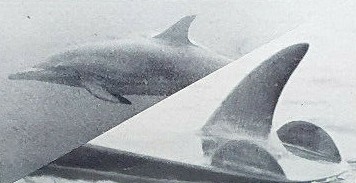 |
1971
Reno Abellira : Tri-fins.
"The three-fin boards are a product of the
consciousness inspired by the twin-fin, but there were
other inspirations too: porpoises."
Surfer August 1971 Volume 12 Number 3 |
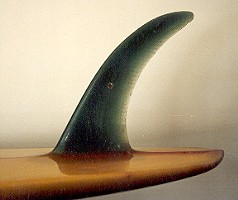
|
1971
Greenough Stage IV
Fibreglass laminate
8 1/2 x 4 1/2 b @ 6
inches
#44
Hutchinson Surfboards |
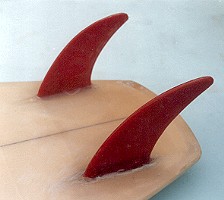
|
1971
Twin Fin 1
Red pigment chop stand
mat,
5 3/4 x 4 b @ 4 inches
Tipped, Toed, note standard symmetric foil.
#71
Walsh Surfboards, Narrabeen.
|
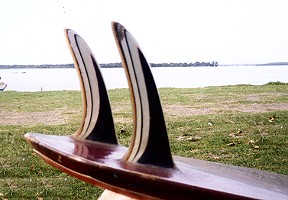
|
1971
Twin fin I
Multi colour laminate
fibreglass
7 x 4 b @ 4 inches
(approximation)
#106
Pat Morgan Surfboards |
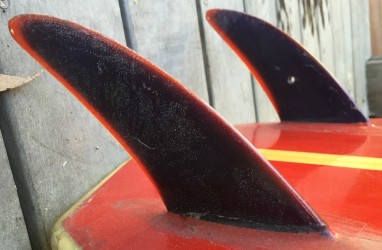
|
1971
Twin fin I
Multi colour laminate
fibreglass
6 x 4 b @ 4 inches
(approximation)
Shane Surfboards |
 |
1971
Twin fin I
Terry Fitzgerald Design
Multi colour laminate
fibreglass
6 x 4 b @ 4 inches
(approximation)
Shane Surfboards |
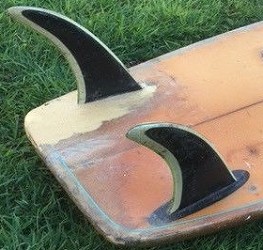
|
1971
Twin fin I
Multi colour laminate
fibreglass
7 x 4 b @ 4 inches
(approximation)
McGriggor Surfboards |
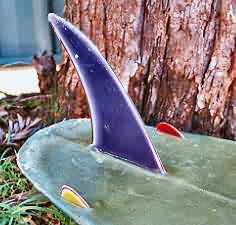
|
1971
Tri fin
Laminated fibreglass
Centre fin : 5 layer laminated
fibreglass
8 1/2 x 6 b @ 4 1/2
inches
Side fins : 5 layer laminated
fibreglass
3/4 x 2 b @ 6 1/2 inches
.
Note the rail fins' asymmetric foil.
#211
Shaped by Dan Calohan , Plastic Fantastic Surfboards,
USA. |
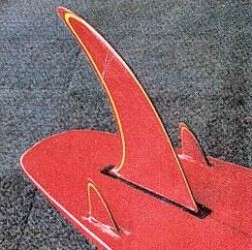
|
1971
Tri fin
Three way fibreglass
laminate
Single fin fixed in internal
fin box.
8 x 6 b @ 5 inches
Two wide base side fins
2 1/2 x 2 1/2 b @ 8
inches
#9
Bob McTavish Tri Fin
Bennett Surfboards |
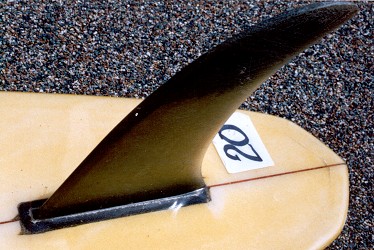
|
1971
Internal fin box.
Fibreglass laminate
Single fin fixed in internal
fin box.
Barry Bennnett Surfboards,
circa 1971.
Estimated : 8 x 6 b @ 5
inches
Photograph Sydney Surf
Auction,
Mona Vale Hotel,
Sydney, 25 - 26 September
2003
Catalogue No. 20
Thanks to Mick Mock.
|
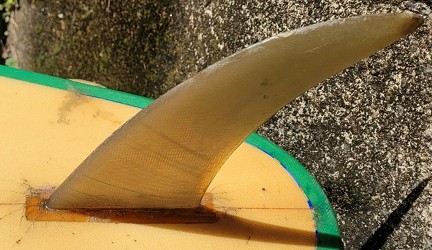
|
1972
Internal fin box.
Fibreglass laminate
Single fin fixed in internal
fin box- base plug?
Shane Surfboards, Brookvale,
circa 1972.
Note the stress marks in base of the
fin, and that the board was later fitted with a
leg-rope plug.
|
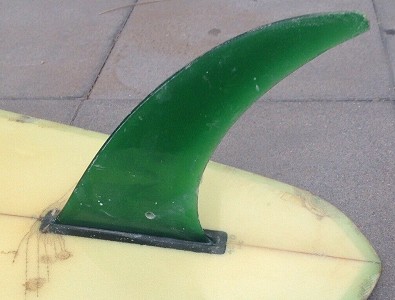 |
1972
Internal fin box.
Fibreglass laminate
Single fin fixed in internal
fin box- base plug?
Egan Surfboards, Newcastle, circa 1972.
Shaped by Peter Cornish
Note the hole for a leg-rope and the stress marks in front
of the fin |
 |
1971
Pat Morgan Keel Fin
Three way laminated
fibreglass, 5 x 10 b @ 1 1/2 inches (estimation)
Image, with thanks, by Darren
Johnston.
4.75'' x 26 " base @ 0''
TRACKS March 1973 Number 30 page 29 (?).
Design:
Pat Morgan Pintail Keel 7ft 7'', Finlength: 24''
(?)
Twin
Keel 6ft 2'' x 20'', Fin length: 21'' (?) |
|
|
1971
Tri fin
Fibreglass laminate
Single
fin 8" x 6" base @ 5 1/2 inches and two rail fins
- blue
laminate
Possible
post production?
Bob Cooper Surfboards: Summergun
|
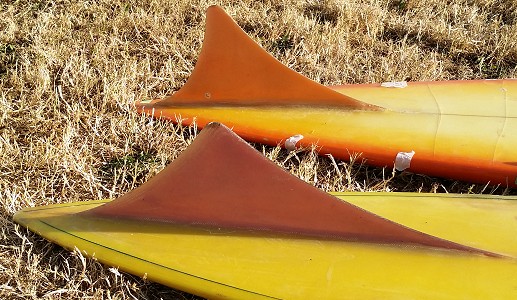
|
1972
Pat Morgan Keel fins
Thanks to Snazzy, 2020.
|
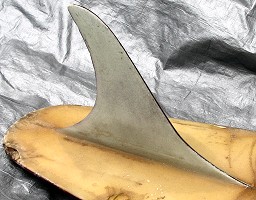
|
1972
Pat Morgan Keel fin
, (second generation?)
Three layer laminate,
white , mauve, white
9'' x 13 3/4'' base x
0'' span. @ 3''
Thin with light foil on
trailing edge. |
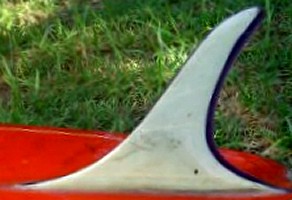
|
1972
Pat Morgan Keel fin ,
(second generation?)
Two layer laminate,
white and mauve
10'' x 14'' base x 0'' span. @
3'' (estimated)
Thin with light foil on
trailing edge.
Image supplied by George of
Geelong, November 2009. |
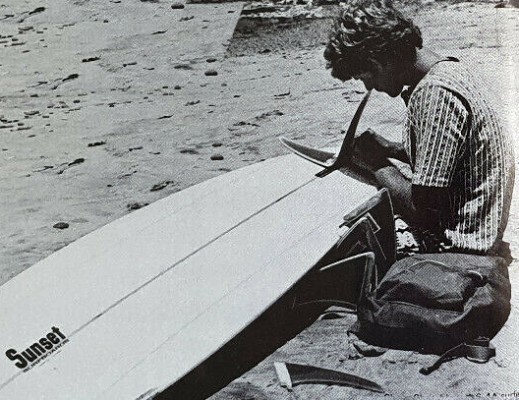
|
1972
Fins Unlimited: an evolving system
Surfing like everything
else is a constantly evolving medium.
During the past 6 years of surfing's evolution, Fins
Unlimited has perfected fin systems that have opened
new areas of the wave.
After all, the fin is the key.
It holds you in trim, creates a pivot point for
turning and affords directional stability and speed.
And what seems more logical than being able to
interchange foil design, outline, depth and the
flexibility of your board's fin to wave conditions, as
well as adjusting fin position forward and aft for
fine performance tuning.
For a fin system as variable as the ocean environment,
insist on Fins Unlimited, the variable interchangeable
fin system.
Cheer Critchlow #6 4A surfer designer has plugged into
the evolution of Fins Unlimited.
Fins
Unlimited PO Box 375-F Encinitas California 92024
(???) 753-8847
Surfer August 1972 v13n3 page2.
|

|
1973
Keel fin
Laminated
fibreglass
4'' x 24'' base x 0'' span @
0''
|
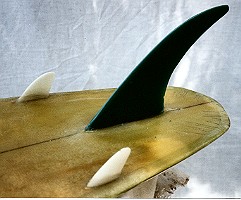
|
1971
Tri fin
Fibreglass laminate
Single
fin 8" x 6" base @ 5 1/2 inches
- green
laminate
Post
production two wide base side fins
2 1/2" x
2 1/2" @ 12 1/4 inches - white. |
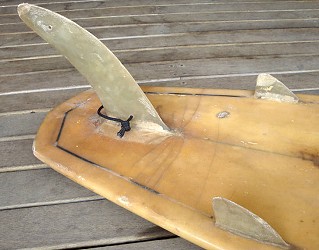
|
1972
Tri fin
Fibreglass laminate
Single fin, with legrope hole.
8 x 4 b x 8 span @ 5 inches
(estimated)
Two wide base side fins
3 1/2 x 2 1/2 b @ 13 inches
(estimated)
Dolphin Surfboards
South Australia?
-probably not a professional
manufacturer.
Image emailed by George from
Adelaide, October 2008.
|
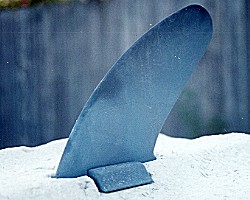
|
1972
Rubber fin
6 1/2 x 4 1/2 b @ 8
inches
Fixed through board with
wedges, shown.
#34
Coolite
Midget Farrelly Surfboards |
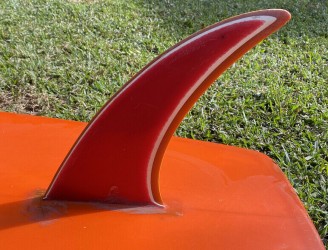
|
1973
Three colour laminated fin
Barry Bennett Spoon-deck knee-board: 4ft 11".
Resin glue line stringer, full orange tint, Number 7302.
See #68. |
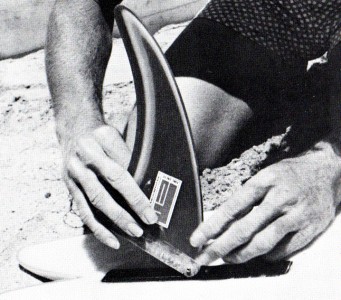
|
1973
Fins
Unlimited Finbox.
Don't get stuck with one
fin in one place!
Tim Lynch, Gordon and
Smith Surfboards (detail)
Fins Unlimited, Encinitas,
California.
See:
The
Bonzer.
Surfer, Volume 14
Number 3, page 4.
September 1973.
|
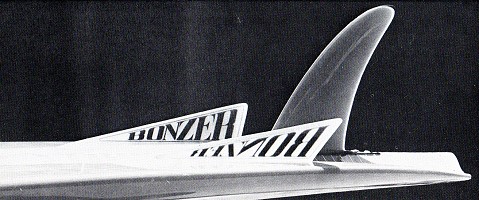
|
1973
Bonzer fins
See:
The
Bonzer.
Surfer, Volume 14
Number 3
September 1973. |
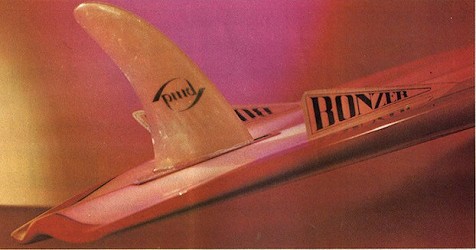 |
1973
Bonzer fins
Bing Surfboards, California.
Campbell Brothers |
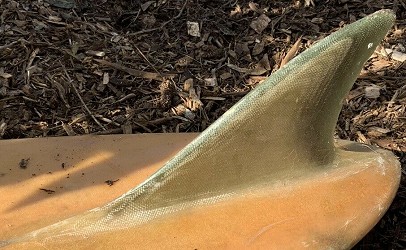
|
1973
Semi-Keel
Phil Grace Surfboards,
Seaford,
Victoria.
|
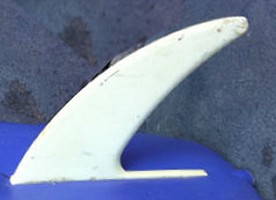
|
1973
Pipeliner fin
Plastic moulded fin in fin box
for a juvenile board, approximately 5ft 4''.
No dimensions.
Fin image forwarded by Sammy
S., October 2011.
|
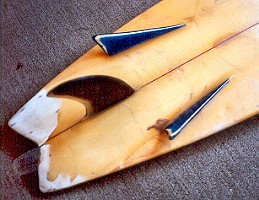
|
1974
Bonzer fins
Original design by Cambell
Bros. USA
Centre fin : black and clear
laminate
7 1/2 x 5 1/2 b @
6''
Bonzer / Keel fins :
blue/white/blue laminate
2 x 9 1/2 b @ 12''
#180
South Coast Surfboards |
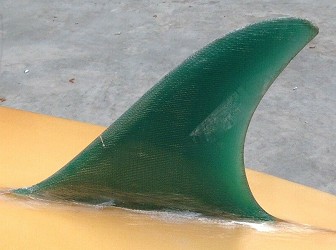 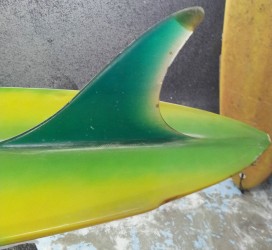 |
1974
Long-base Keel fin
Bruce McKean Surfboards
Mooloolaba,
Queensland.
Free Flight Surfboards
Ballina
NSW
Phil Myers
Estimated: 8'' x 12.5'' base x 0'' span. @
3.5'' |
|
1974
Klemm-Bell Surfboards Bonzer
|
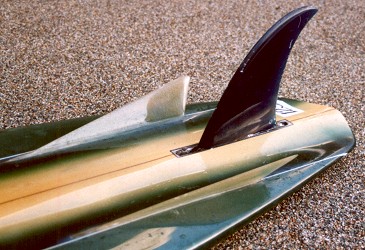
|
1974
Weber S/b Bonzer
Centre fin box : 8 inch @ 4
1/2''
Centre fin :
Moulded wide base, thick
profile, rear fin tab.
7 1/2 x 5 1/2 b @ n/a
inches
Bonzer / Keel fins : 2
1/2" x 9 1/2'' base @ 9''
Not toed in, parrallel to
stringer.
Tipped out at 45 degrees
Thin, not foiled.
Clear laminated.
#198
Weber Surfboards, USA |
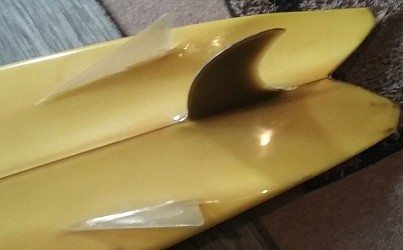
|
1974
Skipp Surfboards, Wollongong
Bonzer |
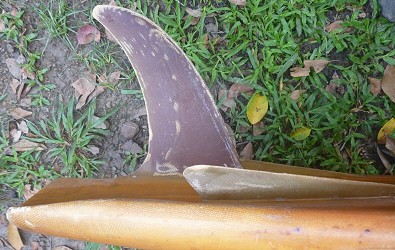
|
1974
Bonzer
Centre fin: 10" x 6" base
Goodtime Surfboards: Scooped-deck Knee-board
Shaped by Brian Austin
5'6'' X 22'' |
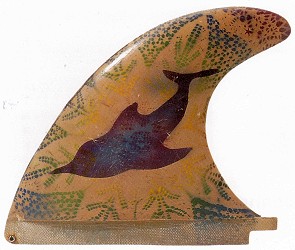
|
1974
Mike Hynson Dolfin
Fibreglass and decoration
8 x 8 b @ n/a inches (Approximation)
USA
Base tongue at rear
C. R. Steck Collection
Photograph : Douglas
Congdon-Martin
Schiffer
page 59
|
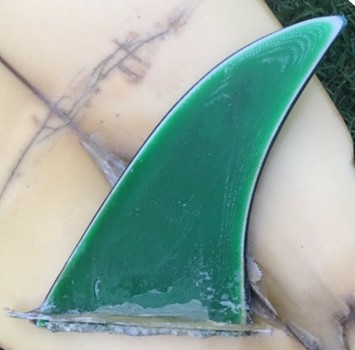
|
1974
Dick Brewer Wide Base
Dick Brewer Surfboards
|
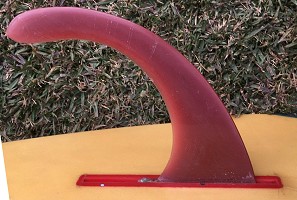
|
1974
Jackson Swallow-tail
Spooned-deck Kneeboard
Hand shaped laminated fin
in fin-box.
See: Jackson Surfboards |
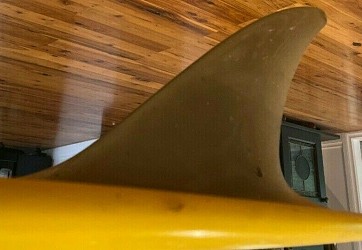
|
1975
Semi-Keel
Phil Grace Surfboards,
Seaford,
Victoria.
1975 Phil Grace
7ft 2" x 20" x 3.5" swallow tail, yellow tint, rail lap,
textured deck, semi-keel fin.
The swallow tail is scooped; while the fin has no leg-rope hole there appears to be remnants of a
leg-rope bridge on the tail.
The owner suggested
It was built in the mid 1970's for a surfer heading of
to Mauritius, as this shape went well in the quality
hollow waves back then.
|
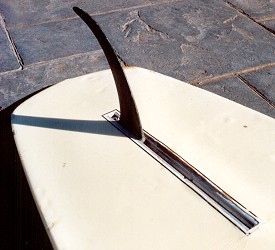
|
1975
Carabine Kneeboard Fin & Aluminium fin box
Fin : 8'' x 3 1/2'' base x 10'' span @
n/a
Aluminium fin box 15 1/2''
Advertisement: The Modern Aluminium Sliding
Fin Box
by Pete and
Geoff's House of Surfing (Geoff Wakefield Surfboards)
5 Good Street, Granville NSW.
Phone 682-1420.
Surfing World Volume 22 Number 1, October 1975.
Dimensions and photographs
at:
Surf's Up At Gerringong
Board Display, August 2005.
Thanks to Scott Andrews
|
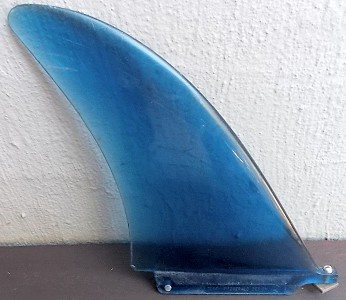 |
1975
Terry Fitzgerald
Design: P/N TF.1
PO Box 93 Byron Bay
NSW Australia
Hot Buttered Surfboards,
Brookvale.
Height: 8''
|
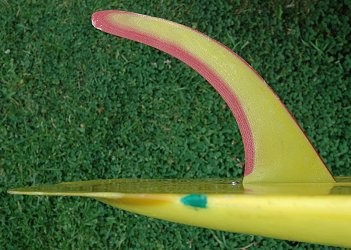 |
1975
Crozier Kneeboard Fin (Copy)
& Flex
tail
Copy:
Donkey Dick Fin (NZ)
8'' x 3.5'' base x 10'' span @
n/a ???
Fin box 15.5'' ???
Photograph supplied with thanks by David Smythe,
New Zealand January 2006.
In April 2018, Charles Carter noted:
The yellow and pink fin was shaped by me! I had Roger
Titcombe cut it from a
blank using a
template of the rather damaged original that came with
the board. The fin shape was referred to as a Donkey
Dick back in the day. (edited)
|
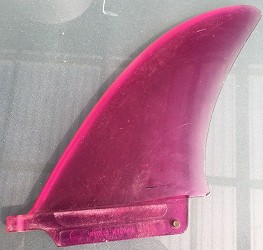
|
1975
Mark Warren
Plastic, Box Fin
Made in Byron Bay MW1
18mm
|
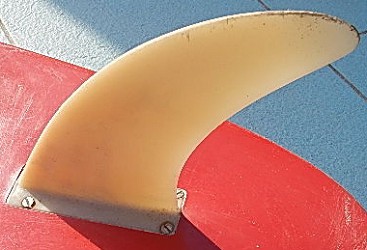
|
1975
Simon Anderson Power-board (Moulded) Fin
Moulded plastic, 8'' x 3
1/2'' base x 6'' span @ n/a ??? [estimation]
Four screws into recessed fin
box.
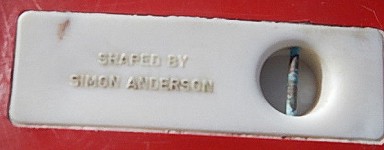
Top of moulded fin-box, identification and
leg-rope plug.
See #381. |
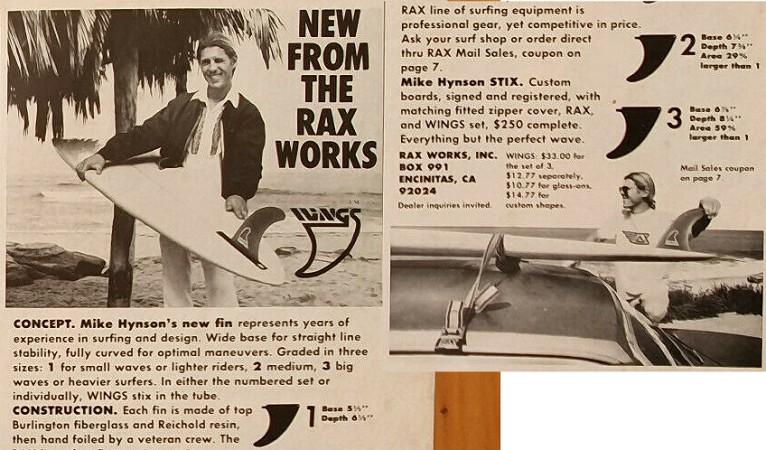
|
1975
Mike Hynson Wings Fins
5.5" base x 6.5"
6.25" base
x 7.5" +29% area
6.5" base
x 8.25" + 59% area
Burlington fiberglass and Reichold resin
...
Hand foiled by a veteran crew.
By Rax Works Inc, Encinitas, California.
International Surfing
v11 n6
December-January 1975
page 4.
|
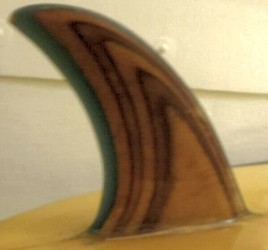
|
1976
Laminated plywood
Ocean Foil Surfboards,
Victoria.
|
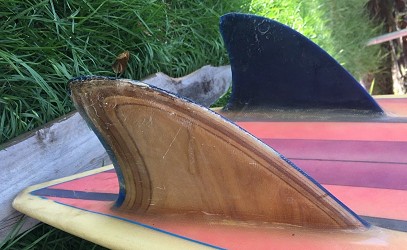 |
1976
Pat Morgan Keel Twin fin
Laminated plywood
5" x 8" b @ 2 inches
|
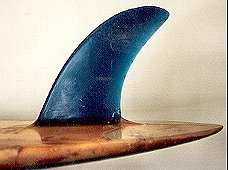 |
1976
Dick Brewer Wide base
Blue laminated fibreglass
8 x 5 1/2 b @ 7 inches
#25
McCoy
Surfboards |
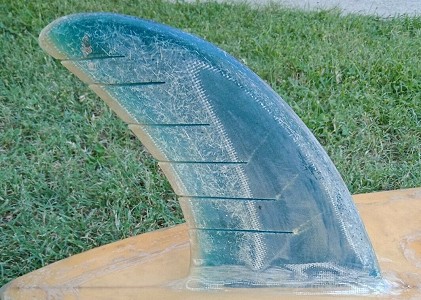
|
1976
Slotted Single Fin
Blue laminated fibreglass
McPherson Surfboards, Angourie,
NSW.
Michael Cundith influence, see Twin Fins below.
|
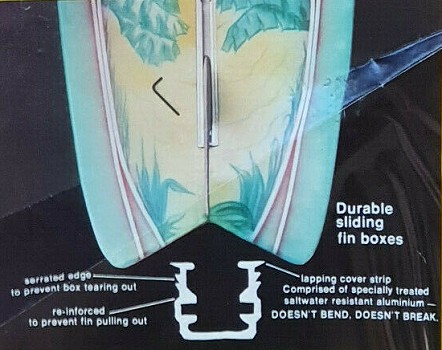
|
1976
Wakefield Aluminium Fin
Box
Pete and Geoff (Wakefield)'s House of Surfing
5 Good Street Granville NSW
(02) 682-1420
Surfing World April 1976 Volume 23 Number 1
- Back cover.
The company manufactured Geoff Wakefield
Surfboards and Saltwater
Surfboards.
They also produced Skateboards
and the aluminium fin box.
They also marketed a range of
surf-wear under the Saltwater label and subsequently moved to Parramatta and the Central Coast.
Also see 1974 Carabine Kneeboard Fin above.
|
 |
1976
Ashley Spoon Flex Fin.
Ashley Surcrafts, later Ashley
Kneeboards.
17
Anderson Street, Torquay, Victoria. |
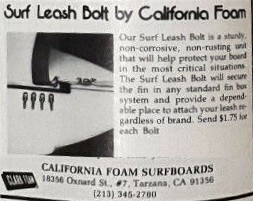
|
1976
Surf Leash Bolt
California Foam, Tarzana, California.
A fin bolt with a hole in the
head to attach a leg-rope, or leash.
Note this was specifically for US designs where the
fin tab was at the rear of the fin, whereas in
Australia the tab was at the front of the fin.
International Surfing
Volume 12 Number 3,
June-July 1976, page 14. |
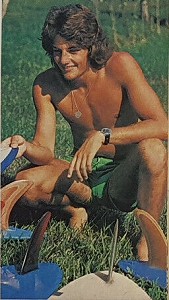
|
1976
Shaun Tomson and Single Fin Quiver.
International Surfing
Volume 12 Number 3,
June-July 1976,
page 65. |
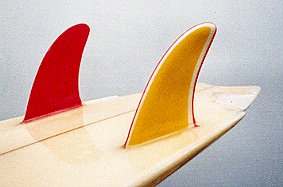
|
1977
Mark Richards' Twin fin II
Three colour laminated
fibreglass
6 x 5 b @ 7 inches.
Mark Richards Surfboards, Byron
Bay.
#40
|
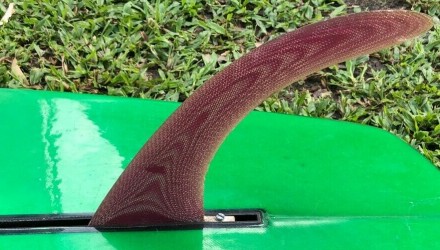
|
1977
Kneeboard Flex Fin
Crozier Surfboards, Mona Vale
NSW
Note the fin tab is at the rear of the fin, unusual
for Australia.
|
Following
its brief period of popularity
in the early 1970s, the
twin-fin retained some enthusiasts and the design continued to
be refined.
By 1976, the asymmetric foil, with
the flat on the inside, had become the accepted format for
twin-fins, and was later applied to the rail fins on three-fin
boards, notably Simon Anderson's Thruster, see below.
Regardless of technical
considerations, given the three possible options setting the foil, this method is the most aesthetically pleasing.
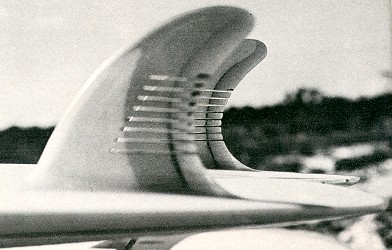
|
1977
Michael Cundith Slotted Twin
fin II
Estimate - 6 x 5 b @ 7
inches
Sky Surfboards, Byron
Bay.
Photograph : Don Blach.
Surfer Magazine, June
1978.
Volume 19 Number 2 page 62. |
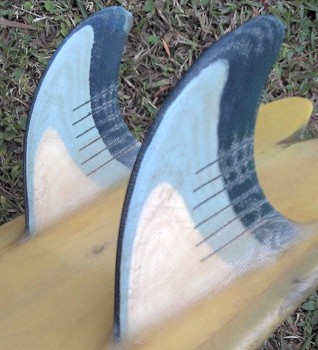
|
1978
Michael Cundith Slotted
Twin fin II
Estimate - 6 x 5 b @
7 inches
Sky Surfboards,
Byron Bay.
|
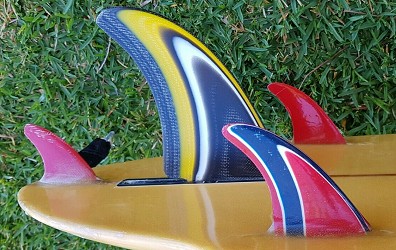
|
1979
1 + 3: Single in Finbox,
Side fins with Trailing Fin
Gold Coast Surfboards
Queensland
???
|
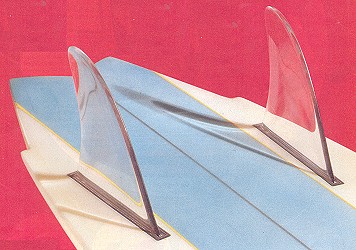
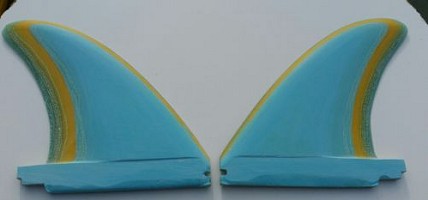
|
1979
Star Systems Twin fins,
Mark Richards Model
Gordon and Smith Surfboards
(USA)
Surfing May
1979.
Volume 15 Number 5, page 9.
|
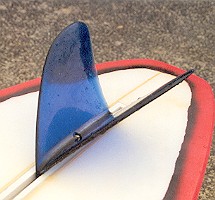
|
1978
Butterfly Fin
Molded plastic
Fin box.
6 x 5 b @ n/a inches???
Honey Surf, Gerringong NSW
Previous version
Velsy-Jacobs Surfboards, USA circa 1955.
#73 No.1
Gordon and Smith Lazor Zap |
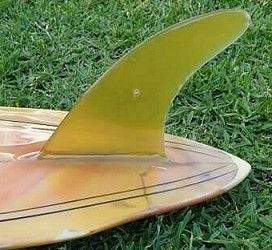
|
1979
Wide base single fin.
Hot Buttered Surfboards
Flyer pintail, Designed by Terry Fitzgerald |
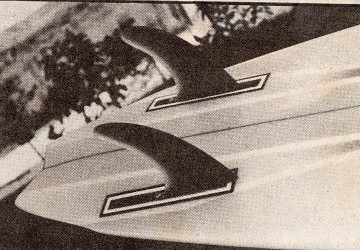 |
1979
Asymmetric Twin Fins
Chris
Brock and Bob McTavish
at Sky Surfboards:
The fins can be set (asymmetric) or moved and down the
boxes depending on wave size and wave conditions.
Tracks, April 1979, page 39.
Presumably set up for a natural-footer, the backhand fin
is at the front of the fin-box.
|
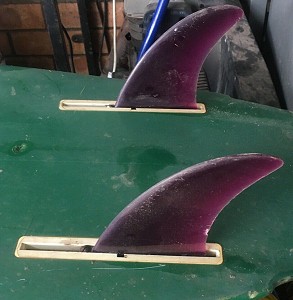
|
1979
Twin Fin Boxes
Bob Copper Surfboards, Coffs
Harbour.
|
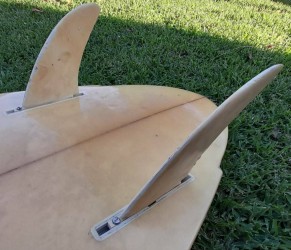
|
1980
Twin Fin Boxes
Aleeda Surfboards, 6ft
double flyer pintail, Mark Warren/Multi Fins.
|
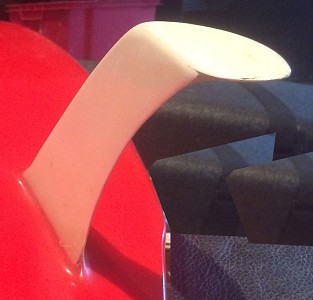
|
1980
Michael Anthony Channel
Power Twin-fin
Springer Surfboards. |
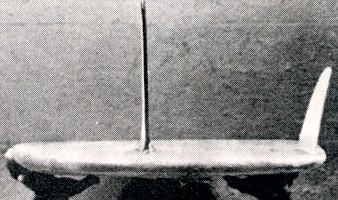
|
1980
Peter Drouyn Asymmetric Twin
Fins
Photograph : Jeff Hornbaker.
Surfing Magazine,
September 1980
Vol 19 Number 9 Page 87 |

|
1980
X fin
Scott Bucknell,
Race Surfboards, Hawaii
Photo:Jim Russi
FROM WHERE? |
Bill Barnfield http://www.ragingisle.com (noted
Hawaiian shaper - ) emailed in December 2005...
The X-Fin was
created by Scott Bucknell of Race Surfboards in Haleiwa,
Hawaii.
He had a shop on Kam highway across from mine for a long time
but not anymore, but he still lives in the area.
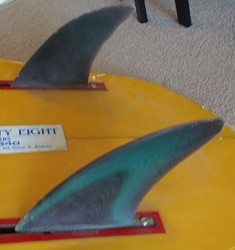 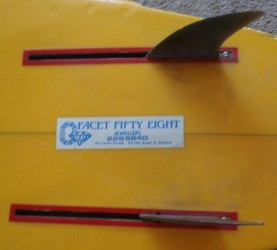
|
1980
Twin fin boxes
Knee-board: Crozier Surfboards
|
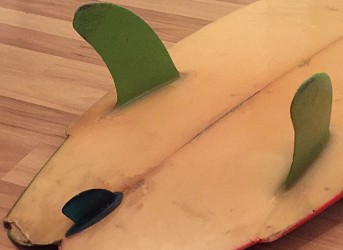 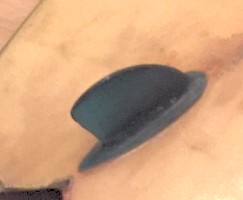
|
1980
Adhesive Trailing Fin on
Twin-fin
Plastic
Sky Surfboards, shaped
by Darryl Bulger. |
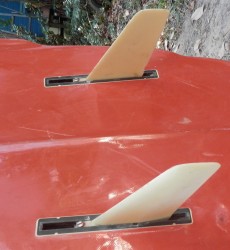
|
1980
Jet-wing Twin Fins.
Earth Rise Kneeboards
Steve Artis
|
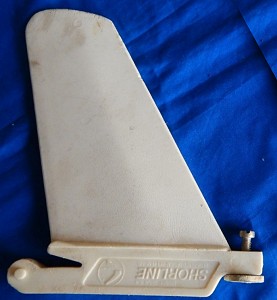 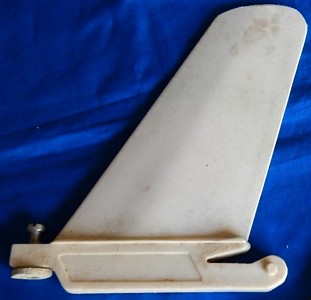
|
1980
Shorline (Twin) Fin.
Height: 5.5"
Base: 3"
Australian Made
|
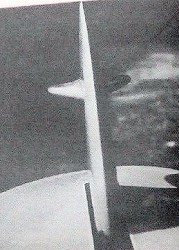
|
1980
Surf Lock T Fin Thing
Distributor: Chris
Beacham.
Tracks,
September 1980, page 10.
Photo and review: Martin Tullemens
|
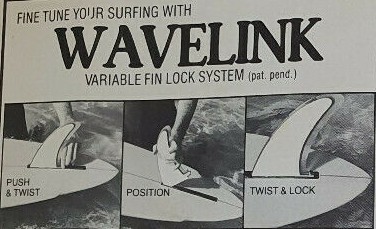
|
1981
WaveLink Variable Fin
Lock System
Fine tune your board to changing wave conditions
instantly.
Change position of your fin on the beach, or in
the water, with a simple twist
improve your surfing performance and increase
your water time.
Made with glass reinforced nylon for
strength and durability.
FU- Shorelines Products
Encinitas, California
Surfer v22 n8 1981 August page 16.
|
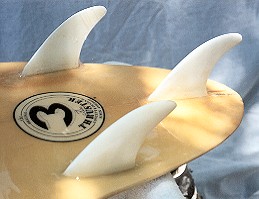
|
1981
Thruster
laminated fibreglass
Three fins 4.5 x 4.5 b
The rail fins are asymmetrically foiled, as if twin-fins.
Design by Simon
Anderson.
Energy Surfboards, Brookvale.
See:
#95
|
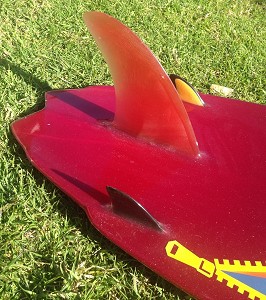
|
1981
Drifta Mk 3 (Tri-fin)
Laminated fibreglass
Centre fin: 7.5 x 4.5 b @
4.5 inches (estimation)
Rail fins: 2 x
2.5 b @ 8.5 inches (estimation)
Design by Terry Fitzgerald.
Hot Buttered Surfboards,
Brookvale.
Reprising the short lived Tri-fin
of 1971, see above, note
that the Drifta
Mk3 rail fins are
flat on the outside and foiled on the inside, reversing
the common format.
Terry was a smart guy (he went to university) and he did
his homework- "technically," this should be the correct
foil template for rail fins.
|
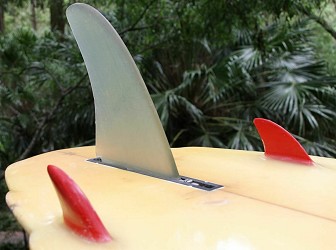 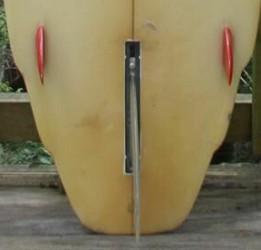
|
1981
DriftaTri-fin
with centre fin-box.
Laminated fibreglass.
Note the side or rail
fins have the familiar foiling- flat on the inside and
foiled on the outside, in contrast with the Drifta Mk III
above.
Also note the rail fins are parallel to the stringer and
not tipped in.
|
|
|
1981
Nat Young Tri-fin.
Centre Fin:Greenough Stage IV by Nat Young
7.75'' x
5'' b x 7.75'' span @ 7.75''
Side
Fins:
4.75'' x
4.25'' b x 6.25'' span @ 12.25 inches
Note the side fins are set off
the rail:
Front @ 3.75'' and Rear
@ 2.25''
Also in
tri-fin format with fin box. - Not shown.
|
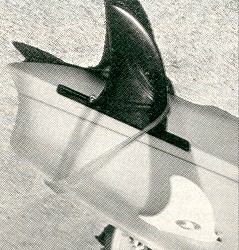
|
1981
Peter Townend Bi - Fin
Bronzed Aussie Surfboards/
G & S Surfboards
Asymmetrical board template and
corresponding asymmetric fin placement.
Surfer Magazine, October
1981 Volume 22,
Number 10, page 42.
Photograph : Guy Motil
See:
Peter
Townend : Two,
Two,
Two Boards in One (Bi-fin.)
SURFING Magazine, June 1981 Volume 17 Number
6 page 27.
Bob McTavish : The
Asymmetric Story
Seanotes Magazine, 1978 |
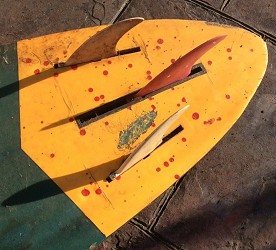 |
1981
Tri-fin Adaptation.
Late-1970s
single fin with added fin-boxes
to update the board to Simon Anderson's new Thruster
design.
Probably by a novice surfer, the rail fins are tipped out
from the centre line.
|
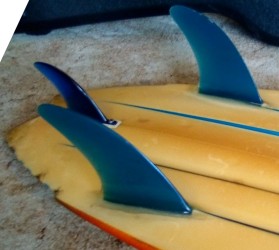
|
1981
Twin-fin with Trailer fin in Box.
Local
Knowledge Surfboards
Gold Coast, Queensland.
|
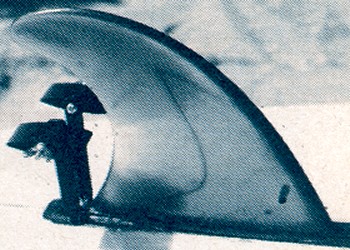
|
1981
Omni Fin (Uncredited)
Plastic
Surfer Magazine,October
1981
Volume 22, Number 10, page 43.
Photograph : Michael Hicks
" The Omnifoil consists of a
bracket which attaches to the rear of the fin box, and
suspends two diamond-shaped foils. These foils may be
easily adjusted upward or downward to create tail lift
or bite. The upward position makes for a hydrofoil
effect, allowing the tail to ride higher in the water.
The downward adjustment works in the opposite manner,
acting essentially the same as a bigger fin for use in
big or choppy waves. The asymmetrical positioning of the
foils to enhance certain types of backside and frontside
turns, is presently being explored."
Precedent by Mike Dolye &
Rusty Miller, circa 1967. |
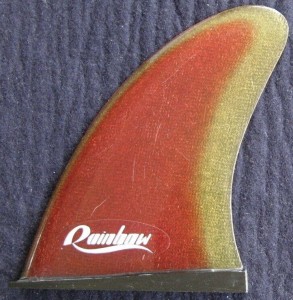 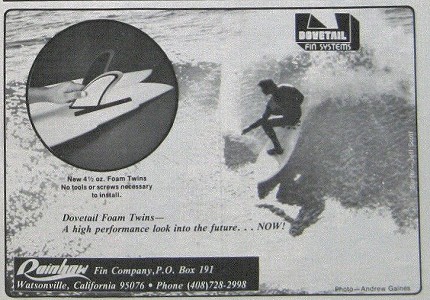
|
1981
Rainbow Twin Fin - Dovetail Fin System
4.5 ounce Foam Twin Fins
- no tools or screws necessary!
6" x 5" (b)
Rainbow Fin Company
PO Box 191, Watsonville, California, 95076
Phone: (408) 728-2998
Surfer
Volume 22 Number 11 November 198, page
29. |
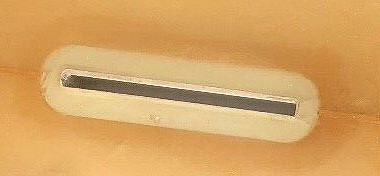
|
1982
O'Fish'l : Composite
Surfboard Fin Systems Fin Box
Mike Davis Surfboards, Kiama.
|
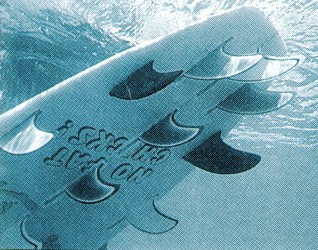
|
circa
1982
MultipleFins (Uncredited)
Laminated fibreglass, fixed and
boxed.
Surfing, March,
1990
Volume 26 Number 3, Page 102.
Included in an article
titled
Dubious Achievements :
"Following Simon
Anderson's development
of the thruster in
1981, surfboard
designers everywhere
decided that if three's
to be, four will score,
five's no jive, six's the
pick, seven's heaven,
eight'll be great..."
|
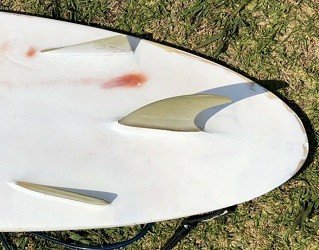
|
1982
Bonzer Tri Fins.
Design by Kent Manning
Bare Nature Surfboards, Byron Bay. |
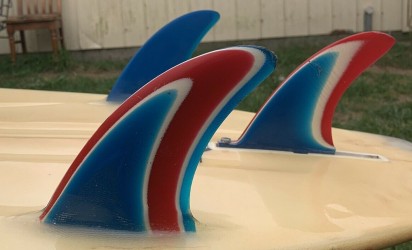
|
1982
Thruster with
Fin-box.
Design by Terry Bishop
Gordon and Smith Surfboards.
Note the trailing fin is slightly smaller and narrower
in the base.
|
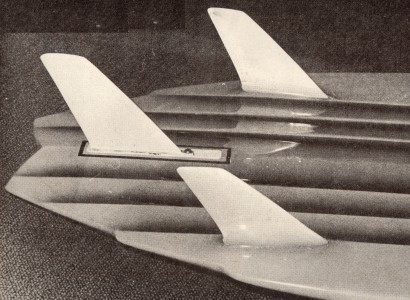
|
1982
High Velocity Thruster
Fins.
Kym Thompson
Water Cooled Surfboards
Tracks
October 1982,
page 27.
|
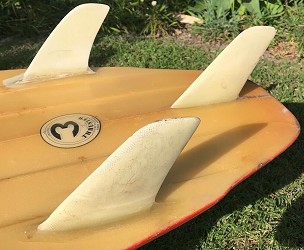
|
1982
Jet-wing Thruster Fins.
Energy Surfboards
|
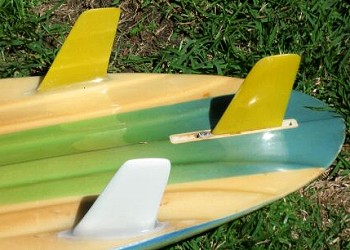
|
1983
Jet-wing Thruster Fins.
Nat Young Surf Design
Fixed rail fins - Centre finbox.
|
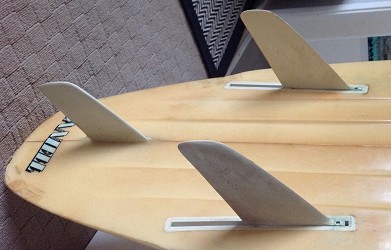
|
1983
Jet-wing Thruster Fins
Daniell Kneeboard
Rail fins in
finboxes - fixed
centre fin.
|
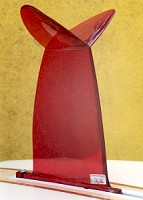
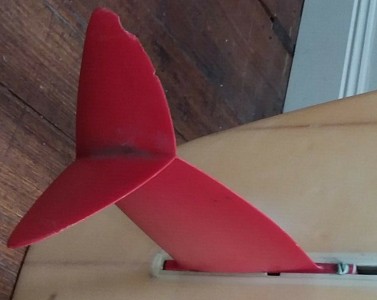
|
1984
Starfin [Winged Keel]
Molded plastic
Fin box.
6 x 5 b @ n/a inches???
" developed by Ben Lexcen in
1984, it was my concept (and) his design, we worked on
it together."
(plus date ajustment and
update of weblink)
http://www.cheynehoran.com.au/starfin.asp
- Cheyne Horan, email July
2013., many thanks to Cheyne.
#73 No.2 Gordon and
Smith Lazor Zap
|
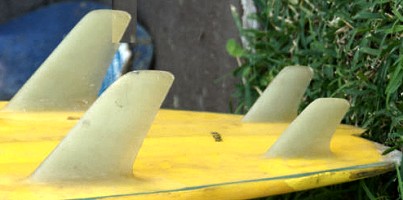
|
1984
Jet-wing
Quad Fins.
Ocean
Rhythm Surfboards, Raglan New Zealand.
Image
contributed with thanks by Muzza, June 2013..
|
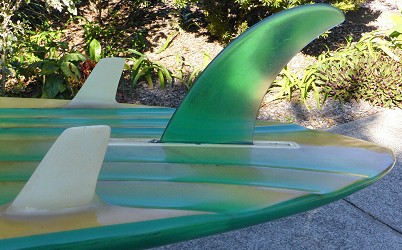
|
1984
Jet-wing
Tri Fin.
Nat
Young Fall Line Surfboards
Shaped by Nat, the period centre fin
may be a replacement, six channels.
|
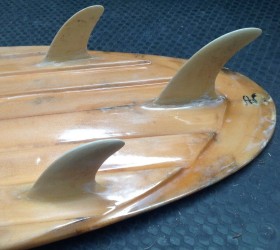
|
1984
Col
Smith Hydro Three Fins.
Sheely
Surfboards
Newcastle
Channel bottom with step-tail
|
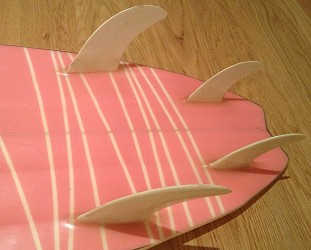
|
1984
Quad
Fins.
Glenn
Winton: Sea Flight Surfboards |
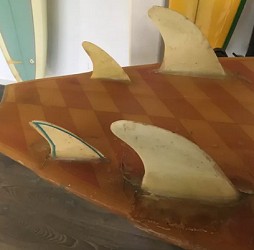 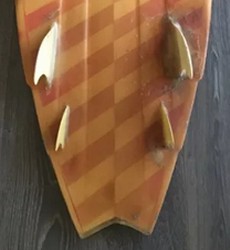
|
1985
Quad
Fins.
Wave
Torque Surfboards |
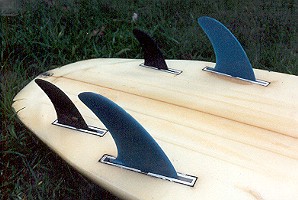
|
1985
Express Kneeboard Quad or
Four Fin.
#206
Following
the success of Simon Anderson's Thruster in 1981,
several variations in fin placement and size were tried,
one being the Four fin by Glen Winton from the Central
Coast, NSW circa 1981.
|
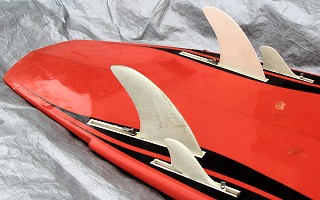
|
1985
Friar Tuck Kneeboard 4 Fin
(Quad)
#343
White
laminated fibreglass
5
1/4 x 5 3/4 base x 7 1/2 inch span
Fitted with rear fin cams.
Dion
Chemicals 10 inch Fin boxes @ 14 inches.
White
laminated fibreglass
2
1/2 x 3 1/2 base x 4 inch span.
Dion
Chemicals 6 1/2 inch Fin boxes
@ 21 1/2
inches
Fitted
with front fin screws - brand? |
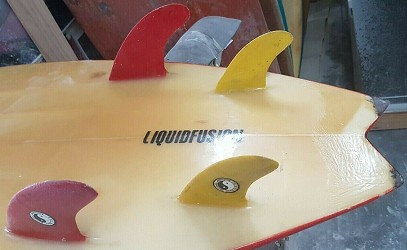
|
1986
Swallow tail 4 Fin (Quad)
Liquid Fusion Surfboards
Shaped by
Peter Young
|
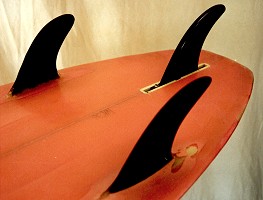
|
1986
Thruster with centre fin box
#31 |
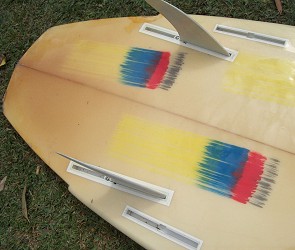
|
1986
Friar Tuck Kneeboard Twin
Fin - 4 Fin (Quad) Boxes
White
laminated fibreglass |
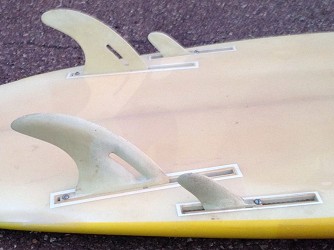
|
1988
Friar Tuck Kneeboard 4 Fin
(Quad)
Slotted
White
laminated fibreglass
|
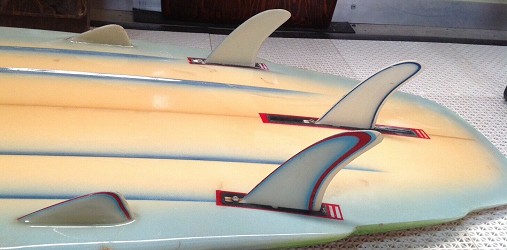
|
1988
Aragon Kneeboard 5 Fin
Bruce Greig: Five Fin
Fever
Laminated
fibreglass: two fixed keel fins and three fins in
boxes.
|
|
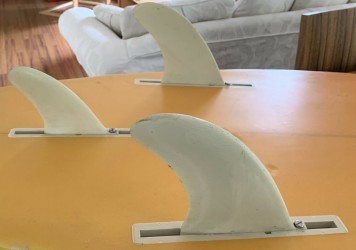
|
1988
Twin Fin and Trailer Fin in
Boxes
Hot Buttered (Surfboards)
Kneeboard
Laminated
fibreglass fins in boxes. |
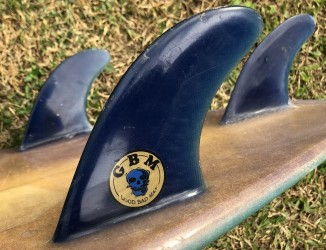 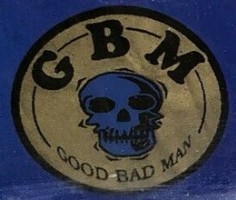 |
1989
Thruster tri-fins by Good-Bad Man
Steve Wilson Surfboards
Evans Head, NSW.
|
Multi
Fins, Byron Bay
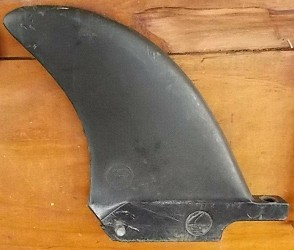
|
1984
Rail Fin by Multi Fins,
Byron Bay
Moulded plastic
4" ... for standard fin box.
|
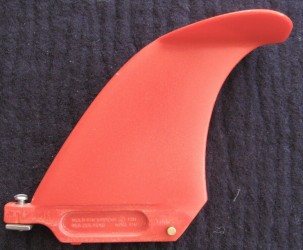 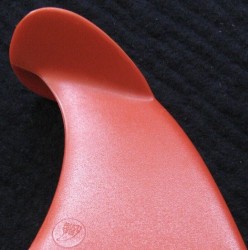

|
1984
Wing Fin by Multi Fins,
Byron Bay
Moulded plastic
Thruster centre fin for
standard fin box.
3.75" x 4" (b)
|
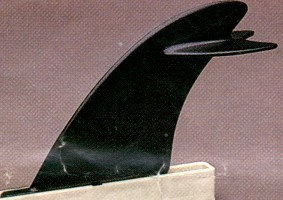
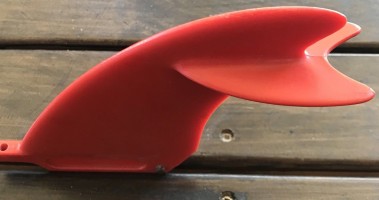
|
1987
Zip Fin
Moulded plastic
Thruster centre fin by
Multifins
Fin box
|
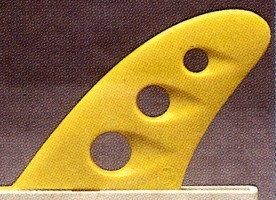
|
1987
Turbo Fin
Moulded plastic
Thruster centre fin by
Multifins
Fin box. |
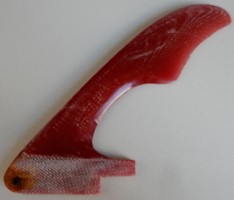
|
1987
Ski Fin
Laminated Fibreglassed
Commonly used on wave skis.
Fin box. |
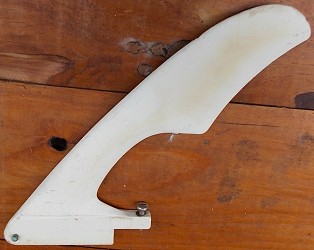 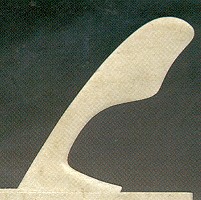
|
1987
Ski Fin
Moulded plastic
Thruster centre fin by
Multifins
Commonly used on wave skis.
7.5 " Fin box. |
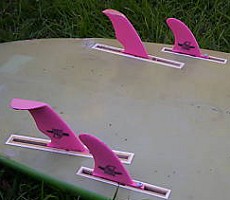 |
1986
Quad Split Wing Assymetric
Moulded plastic by Multifins
Quad fins
Fin boxes.
Image supplied, with
thanks, by John Mattes, July 2009.
|
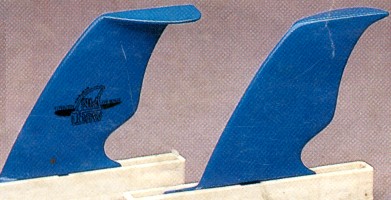
|
1986
Split Wing Assymetric
Moulded plastic
Thruster side fins by Multifins
Fin box. |
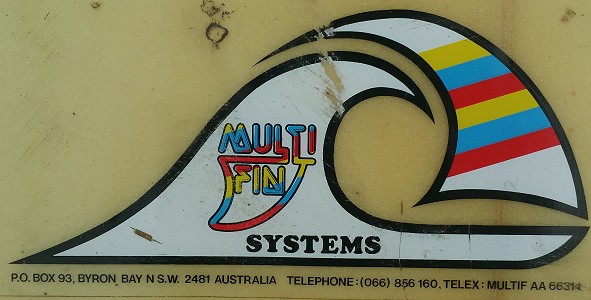
|
1986
Multi Fin Systems
Sticker, courtesy of Snazzy,
February 2019.
|
|
1987
Morey Boogie : Mach 20 RS with Retractable Skegs
The first-generation Mach 20 RS was
considered the top of the Morey Boogie line.
The unique retractable fins could be raised and lowered
using the levers on the deck and lock gently into place.
They had plenty of "give" in case they collide with
objects, for example rocks or a swimmer.
Advertisements claimed that fins offered 'hard edge
control on steep, hollow waves', that one or both could be
engaged before takeoff, and that they could also be left
up 'for speed and spinners'. |
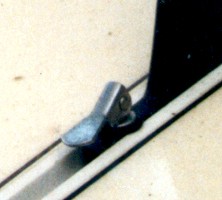
|
1988
Fin Cam
Finger adjustable fin screw. |
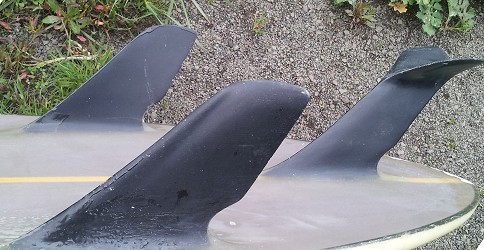
|
1988
Tri-Fin: Split Centre and Two Cutaways
Glenn Jenkins: Custom
Classics Surf Designs
?
Image thanks to Snazzy, January 2019.
|
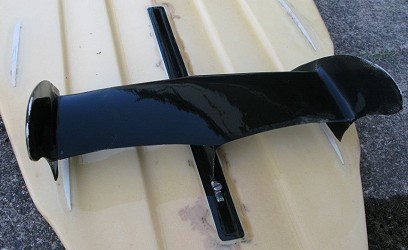
|
1988
Tri-Wing Fins
Kneeboard by Hot Stuff Surfboards
|
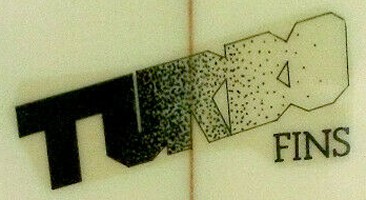 |
1988
Strapper Surfboards:
Scooped Deck - Turbo Fins
|
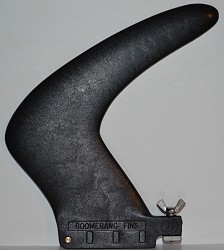
|
1989
Boomerang (tm) Fin
Manly, NSW
Height: 6.25" x 2.75'' (base) x
3'' (span)
|
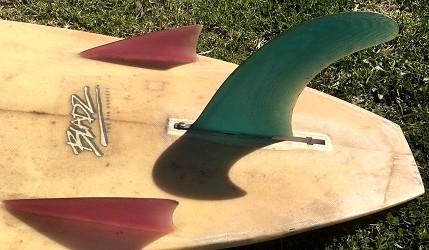
|
1989
Bladz - The Fin Concept
B.M. Surfboards, Gold Coast,
Queensland
B. Milch
|
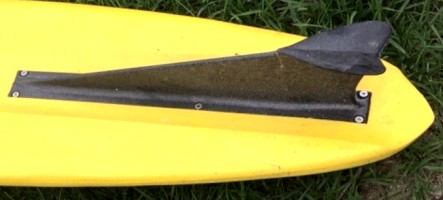
|
1989
Skurfer Winged Long-base Keel Fin
?? |
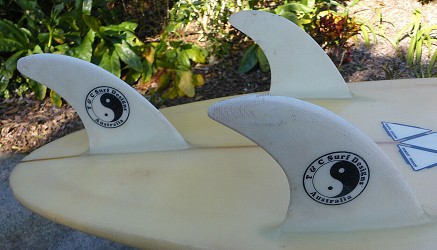
|
1990
Fin and plug decals.
Town and Country Surfboards, Australia.
|
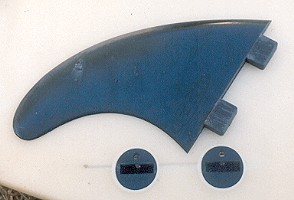
|
1990
FCS removable fins and plugs
# 81
Channel Islands Surfboards
by Al Merrick
|
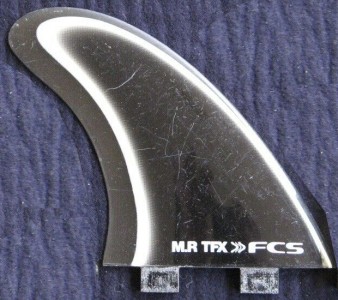
|
1994
FCS
Mark Richards TFX |
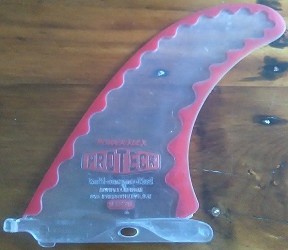
|
1994
Proteck: Power Flex, by Surfco Hawaii.
Flexible leading and trailing edges designed to reduce fin
cuts.
Available as Performance (solid core) Power
Flex (medium core), and Super Flex (flexible
core).
|
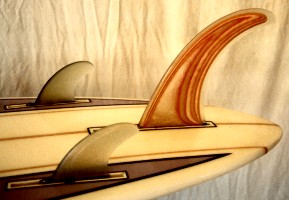
|
1995
Malibu Tri Fins
Glassed plywood centre
fin.
All fins boxed. |
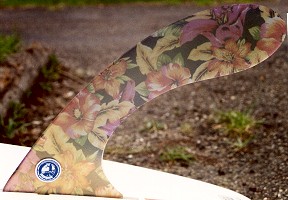
|
1995
Midget Farrelly
Fathead
Laminated fibreglass and cloth
Fin box. |
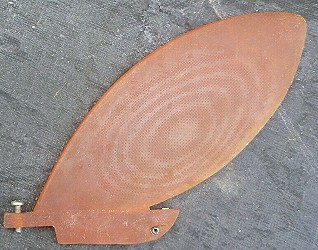
|
1995
Nat Palmer Tear-drop Fin
Laminated fibreglass and cloth
Twin-fins in boxes.
Munro Surfboards
|
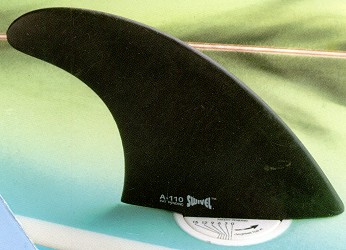
|
1998
Swivell Fin
Available in four sizes
(115,110,100 & 85mm)
Moulded
plastic, Adjustable Fin
Plug.
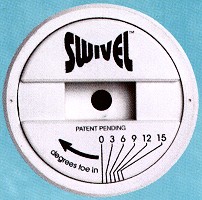
|
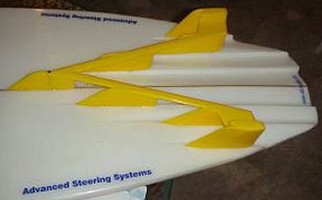
|
1998
Advanced Steering
Systems
(USA) |
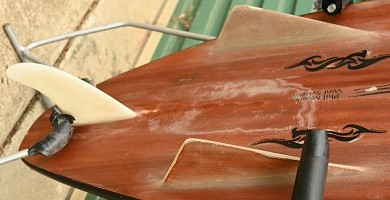
|
1999
Tri-fin with Bonzer keels.
Phil Myers Design:
Beach Boy Surfboards
Noted:
7ft 6"? rounded nose,
rounded square-tail in (epoxy?) wood laminate with foam
core,
Phil Myers recalled the
board was shaped for Steve Butterworth (RIP) and
originally it had 3 keel fins. |
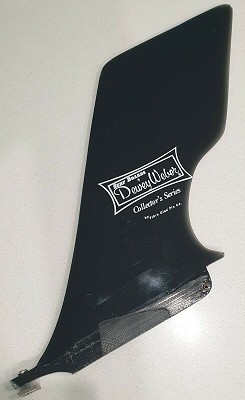
|
1965
Hatchet fin by Dewey Weber
Surfboards
Collectors Edition by Fibre Glas Fin Co.
11x 8"b (Approximation)
Weber Performer
Dewey Weber Surfboards USA
For fin box.
The Hatchet Fin was designed by
Dewey Weber in 1965.
The original template was a massive 18 and was called the
Turn Fin, before adopting the name Hatchet Fin.
The design became
synonymous with Dewey Weber Surfboards Performer model. |
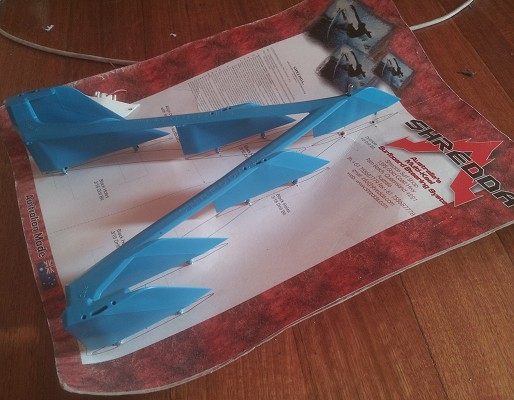
|
2007
Shredda Steering System
Shredda fin setup, inspired by jet fighters, was designed
by Don Smith; a Gold Coast plumber and a former Palm Beach
surf shop owner.
https://360guide.info/surfing/shredda-fin-setup.html
Australia's
Multi-Keel Surfboard Steering System
Shreeda Surfshop
1395 Gold Coast Highway
Palm Beach Queensland 4221
Australia
Phone +61 755687779
Fax +61 755687778
email:
info@shredda.com
web:
www.shredda.com
Image thanks to Snazzy, 2020.
|
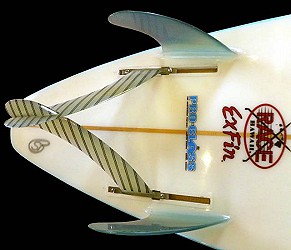
|
1998
Ex-Fin
Laminated fibreglass and
finboxes.
Race Surfboards, Hawaii.
|
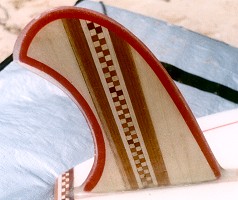
|
1999
Tom Wegner
Laminated fibreglass and timber
Pigmented glass bead
Matching tail block |
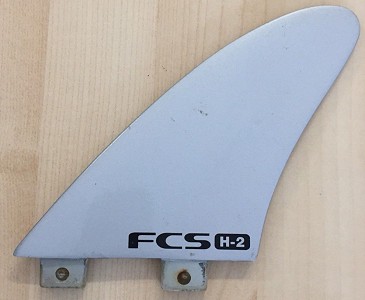
|
2000
FCS H2 Fins
FCS H2 Medium
Fins Size:
Base: 4.22
in. 107 mm
Depth: 4.65 in. 118 mm
Surface Area: 13.95 in.² 9000 mm²
Sweep: 36.5°
Cant: 10°
Toe Angle: .5°
|
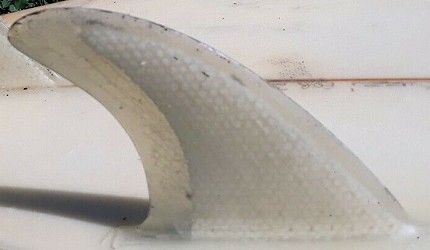
|
2000
Honeycomb Core Fin
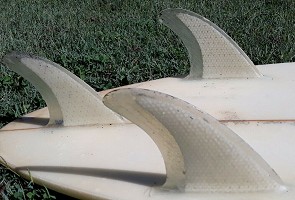 LSD Surfboards? LSD Surfboards?
|
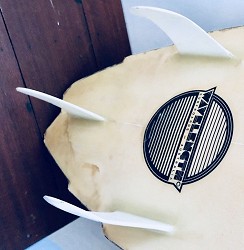 |
2002
XT Turbo Fins
Laminated fibreglass
Strapper Surfboards, Torquay.
|
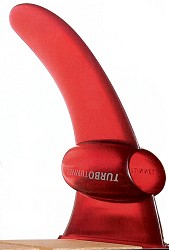
|
2004
Turbo Fin
Moulded Lexan resin
Fin box.
9 1/2'' and 7 1/2'' models
Note Weber Turbo Fin,
circa 1966 - above. |
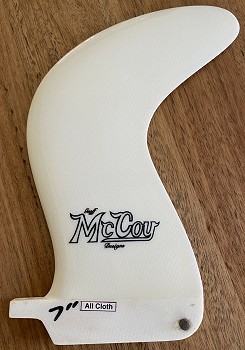
|
2005
McCoy Hatchet S Fin
Geoff McCoy
Designs.
Laminated cloth
Fin box.
7'' model |
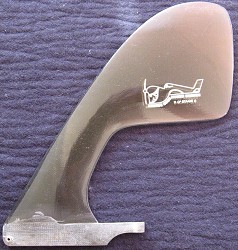
|
2005
George Greenough Stage 6
True Ames, USA.
9" with 3.75" base
A deep cutaway blade fin derived from Greenough's windsurfer
designs.
|
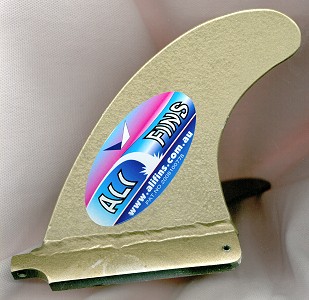
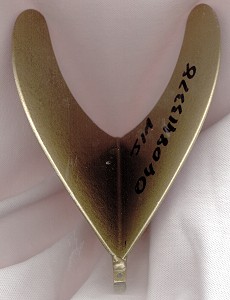
|
2008
Alifin - Rabbit Ear,
Butterfly fin.
www.alifins.com.au
Aluminium
Two blades, each 4 1/2''
height x 4 1/4'' base x 6 1/2'' span.
Depth 4''.
Fin box.
Also avaialble to fit FCS
plugs.
9 cm, 10 cm and 12cm models.
Note Velsey Rabbit
Ear (circa 1955) and Honey Surf
Butterfly Fin (circa 1978) - above.
Image left:
Alifin - Rabbit Ear,
Butterfly fin, 2008.
|
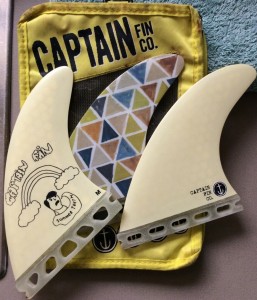 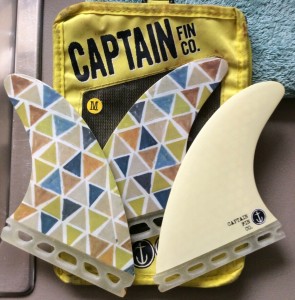
|
2010
Captain Fin Co. Futures Fins
Dane Reynolds Summer Teeth
Thruster set.
Medium size.
|
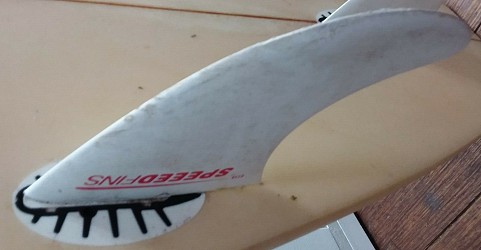
|
2011
Thruster Speed Fin and Plug
USA? |
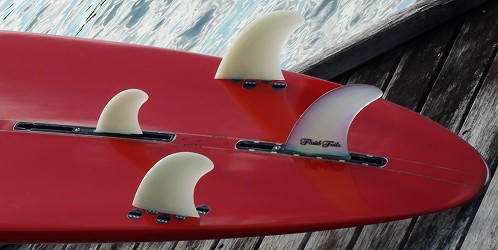
|
2014
Diamond Fin (format)
John
Curby
Noosa,
Queensland.
Clearly made for experimental testing; apart from the
two central fin-boxes, each rail fin has three sets of
FCS plugs to significantly vary the fin toe-in.
|
|
Slide Fins engage like fixed fins for
traditional bottom turn power and drive across the
wave.
The fins only fold in
one direction, thereby providing a strong tail to
build speed.
|
Upon approaching your top turns, the wave
pressure shifts to the opposing flexible face of the
fins, forcing them to release and fold flat.
|
With the fins released and folded against the
board, you are free to continue your slide maneuvers
with low tail resistance.
Surf freestyle and slide like a pro!
|
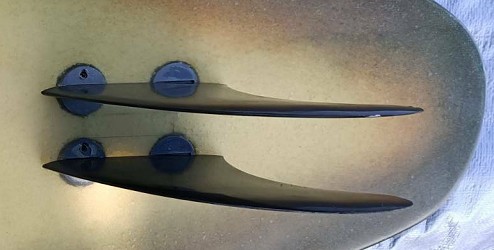
|
2015
Twin Fins
Nicos
Surfboards
Ocean Grove, Victoria.
Custombuilt: 8' 11" x
19.5", twin rear fin set up with single side fins.
FCS plugs/compatible. |
|
2010
Asymmetrical
Four Fin - design by Peter Downes
Asymmetrical surfboard made by
the McTavish crew to my design.
6'6" x 22" x 3"
Unique one off board
designed for goofy foots.
Based on experiments that I did back in the 70's,
this board works amazingly well backhand and forehand.
The fins on the forehand side are parallel to the
stringer, and combined with the diamond tail on the
same side, provide great down the line projection when
you crank off the bottom.
|
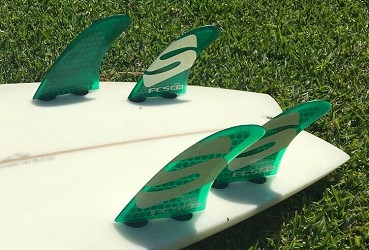
|
2015
Simon Anderson FCS Quad Fin
|
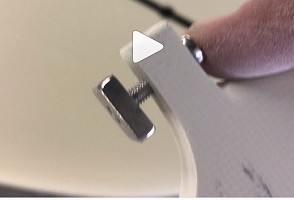
|
2019
D-fin Finbox
Pieter Surfboards, Newcastle, Australia.
Inserting a standard 10" fin-box in the rear of the
board, and grinding off the one end of the box,
facilitates easy fitting for long based D fins and
allows it to be set right at the pod.
Contributed by Pieter, June 2019.
http://pieter.com.au/
|
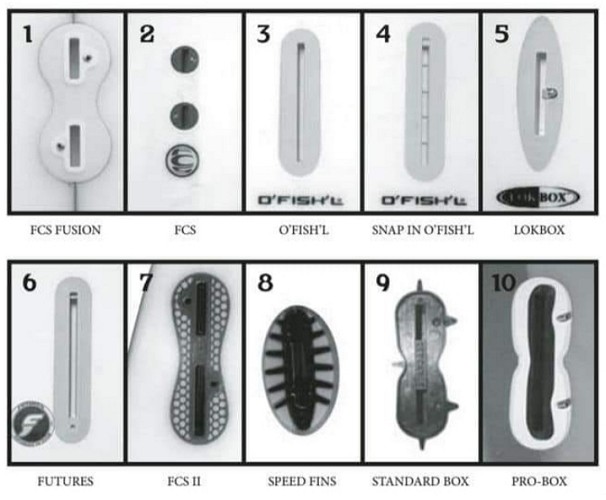
|
2020
Various Types of Fin Plugs
Thanks to Snazzy, 2020. |
the fins of george
greenough
sailboard
fin
catalogue
References
1. John Kelly : Surf
and Sea pages 120-124
2. Uncredited: Malibu Fin
Appendix, in SURFER Magazine, Vol 17 No 2.
1976 June/July
3. Uncredited: Time Machines,
in SURFING Magazine, Vol 25 No 2. 1989 February
4. Paul Holmes: The fin - that
which drives us, in LONGBOARD Magazine, Vol 4
No 5. 1996
November/December
5. Mark Fragale: The Morey-Pope
Thought Factory, in
Longboard
Magazine Volume 6 No 7 January/February 1999 pages 92 - 99.
6. Paul Gross: Moving Forward -
A George Greenough Scrapbook: 1960-19670,
in
The Australian Surfer's Journal Volume 2 No 2 Autumn
1999 pages 68- 121.
7. Paul Gross: Inventions: Tom
Morey, in The Australian Surfer's Journal
Volume 3 No 1 Summer 2000, pages 80 -
89.
Relevant Definitions
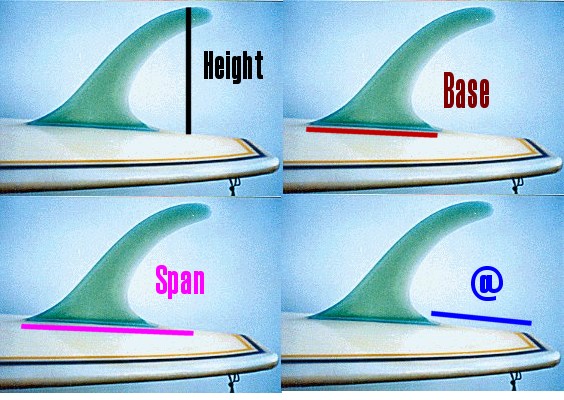 |
HEIGHT (INCHES)
BASE (INCHES)
SPAN (INCHES)
@ (INCHES) FROM TAIL
|
fin / skeg
stabilizing wing attached to the bottom
of the board, usually at the tail.
Dimensions are length (height or
depth), base, foil and surface area (sailboards).
First use credited to Tom Blake
(Hawaii) circa 1934.
Some commentators also recognize the
contribution of Woody Brown and George Downing.
fin area
surface of the fin, usually one side
only, rarely quantified for surfboards but often calculated
on modern sailboard fins.
fin base
length where the fin intersects with
the board.
fin box
A fabricated structure inserted into
the board that allows fin replacement.
Some models allow the fin position to
be adjusted.
Apparently there was some
experimentation was during the solid wood era. but the most
significant application was experiments in the mid-1940's by
George Downing and Wally Froiseth in Hawaii.
They made a test board with a
removable fin slot and rode it with different fin designs in
different positions, and without
a fin.
Their conclusion was that the finned
board had superior performance, virtually regardless of fin
design.
(Kelly,
page 121)
The first production models appeared
in the early 1960s in the USA.
Since many boxes were limited to the
manufacturers' sole fin design, the impetus to manufacture boxed
boards was enhanced by the cost advantages in freighting finless
surfboards.
This was certainly a consideration
for the larger Californian manufacturers in the mid-1960's, for
whom the East coast was a major market.
At first fins were not universally
interchangeable as each manufacturer used a different locking
system, but in in 1965 Tom Morey at Morey-Pope
Surfboards developed the TRAF system of molded fins,
available to a small number of Northern California board makers.
In 1966 the design was improved by
the introduction of thr Wonder Bolt system, again by Tom
Morey.
In February 1968 Morey introduced the
Waveset box and a range of molded fins for general use.
This design was essentially copied by
the Safe Set system.
The most popular and significant fin
designs were by George
Greenough who produced three models - Stage I,
III and IV.
In the late 1960's, continuing
reductions in board dimensions saw extensive fin design
experimentation, with some designers focusing on sideslipping,
note Skipp Frye's New-e-free fins, circa 1969.
The original Waveset box was too
bulky relative to the smaller boards and circa 1970 it was
updated with a male notched fin base slotting and locking into a
molded female box.
This design was replicated by Guidance
Fin
System and other manufacturers.
In 1971 Bill Bahne (USA) introduced
his Fins Unlimited fin box, that by 1974 was to become
universally adopted and replicated.
It is still in current use.
It's huge success was a direct result
of the box's ability to accept laminated fibreglass fins of a
multitude of designs.
Note that ...
- many riders considered the
fibreglass fins superior in performance to molded plastic.
- the fibreglass fins could be
manufactured by any experienced laminator.
- the fibreglass fins could be easily
reshaped and repaired.
- they were interchangable with
boards from different manufacturers.
In Australia in the early 1970's
Bahne's design was manufactured in fibreglass (see #83), but this was shortlived
as the large scale production of molded boxes substantially
reduced the unit price.
In 1974 an Australian company, Wakefield
Surfboards, unsuccessfully attempted to market an
aluminium model.
With an expanding number of fin
designs in the late 1970's for kneeboards, waveskis and the
twin-tin surfboard, boxes were available in a variety of lengths
to either fit small based fins or allow maximum variation in fin
placement.
Many Thruster designs of the
early1980's featured two fixed side fins and a short centre fin
box to allow the rider some variation in fin selection and
placement.
In the 1980's the fin box was an
important feature of sailboard design.
They allowed extensive fin
experimentation and were also fitted into the deck as the mast
track.
As surfboards became finer and
thinner in the late 1980's the use of fin boxes in shortboards
almost disappeared, but in the early 1990's a fin plug system
for surfboards.was developed (initially by FCS,
subsequently by others).
Further developments in the 1990s
include bolt-through boxes for sailboards (Tuttle, USA and
others).
Updated May 2006, thanks to Nick Van
Brugge.
fin dimensions
 |
HEIGHT (INCHES)
BASE (INCHES)
SPAN (INCHES)
@ (INCHES) FROM TAIL
|
fin cam
finbox screw, hinged with a finger grip
and fitted with a rubber grommet that allows fin
adjustment by hand, as opposed to the
normal method with a screwdriver.
fin height
the length of the fin measured
perpendicular to the bottom of the board.
See Dimensions, below.
fin index : a
list of significant fin designs to be catalogued, italics
indicate unlisted designs.
Tom Blake Keel/Nub
Bob Simons Round/Radius
Simons Twin
Matt Kevlin Raked Round/Gun
(Dale) Velzy-(Hap) Jacobs Dee-fin
Velzy - Jacobs Vee/Butterfly
Square/Angular
Phil (Edwards)/Reverse/Pixie,
Nose-fin
Dave Sweet High-drift
Ski and Dive Tunnel/Tunnel Hustler
Greenough Stage I
Dave Sweet Bat-fin
White Owl Flow-Thru
Mike Hynson Dol-fin
(Donald) Takyama Blade
Greenough Stage II
(Reynolds) Yater
Dewy Weber Hatchet
Greenough Stage III
Migdet Farrelly Cutaway
Richard Harvey F-fin
Greek Surfboards Tiger Tail
Skip Frye New-E-Free
Gordon and Smith Hy-Performance,
Rick (Stoner) UFO
Greenough Stage IV
Mike Eaton Twin Fin #1
Steve Lis Fish (twin)
Tri-fin
Pat Morgan (Australia)/D. Barnham
(USA) Keel
Malcom and Duncan Campbell Bonzer Keel
Jeff Ho StraightBack Radial-cut Flex
Michael Cundith Radial-cut Flex
(Dick) Brewer Wide Base
(George) DowningTrailing Edge
Mark Richards Twin Fin #2
Boomerang
Bob McTavish Fence
Wave-ski Cutaway
SimonAnderson Thruster
(Cheyne) Horan/(Ben) Lexan Keel/Winged
Keel/Star
Jimmy Lewis Cutaway
Canard
Glen Winton Four-fin/Quad
Bobby Owens Football
Slotted-fin
757-fin
fin placement
measured as the distance from the rear
of the fin base to the tail or back of the board.
Geoff Cater (1999 - 2022) : Catalogue : Fins
http://www.surfresearch.com.au/f.html















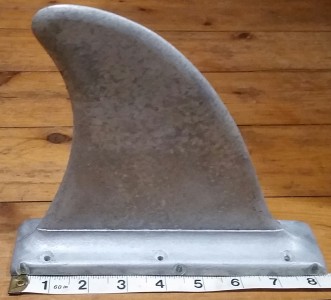
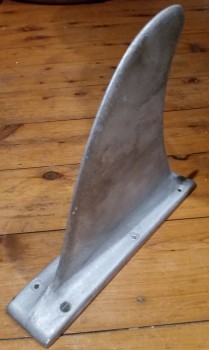
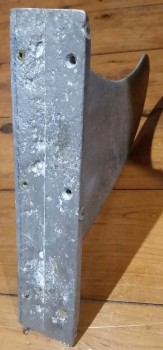

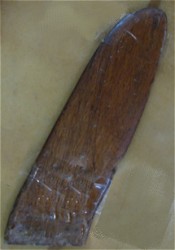
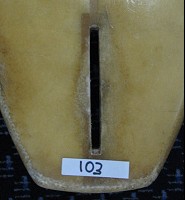





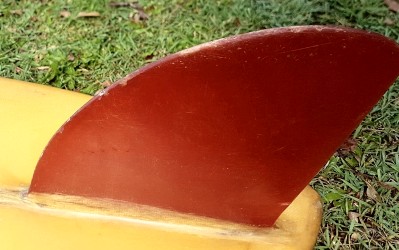









































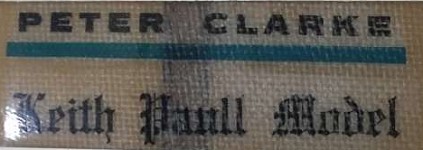































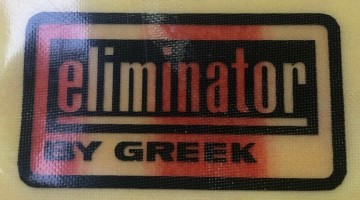



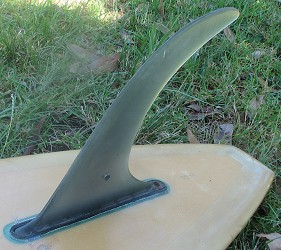























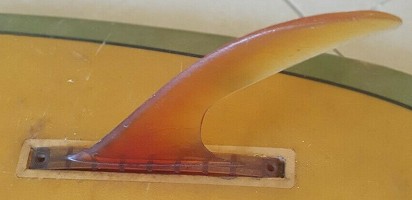








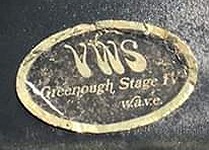
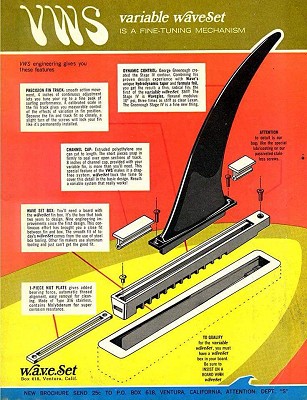










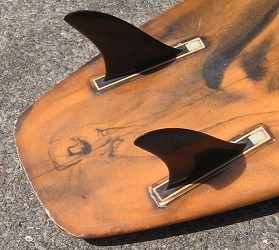
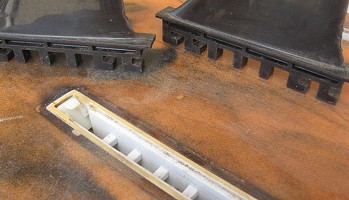








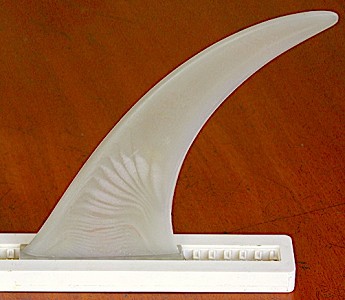
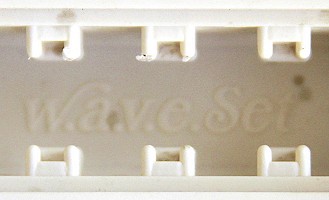
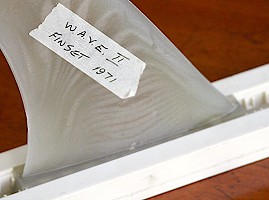



















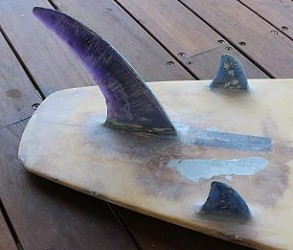














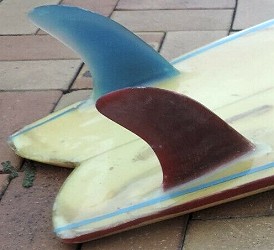


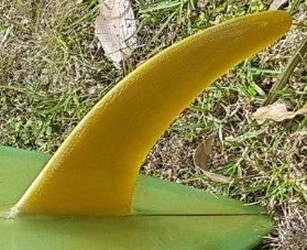


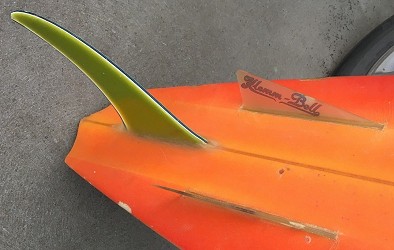
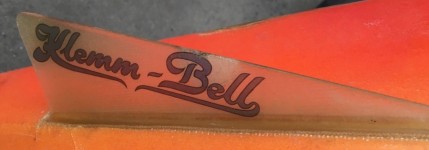





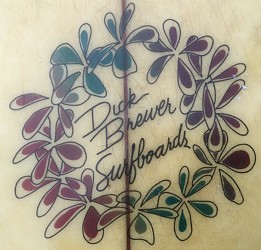
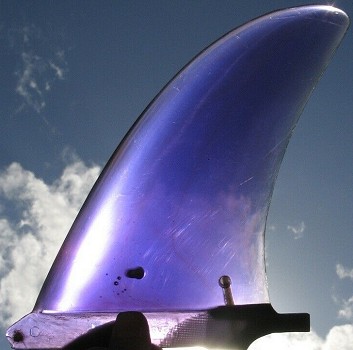

































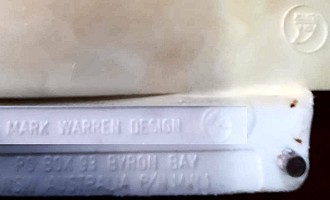

















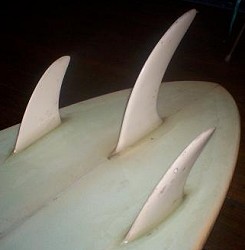
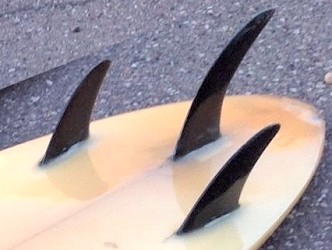






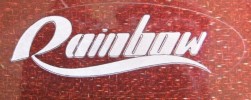





























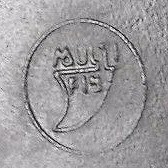



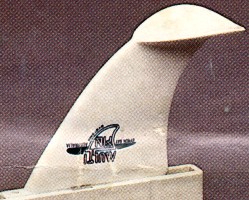


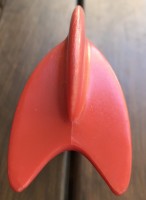











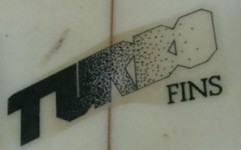


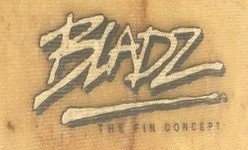


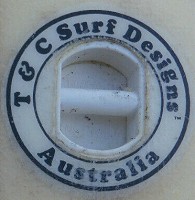
















 LSD Surfboards?
LSD Surfboards?
